“He was a very, very popular math professor” and also “into computers in the sixties, before anyone knew what computers were,” Father Regan said. “He just had such an incredibly interesting life.”
Thus inspired, Father Regan pursued his own career as a Jesuit and an educator. After graduating from Boston College, he earned master’s and doctoral degrees from Fordham in 1982 and 1984; served as a philosophy professor and dean at Fairfield University and Loyola University Chicago; and came to Fordham as a visiting associate professor of philosophy from 2010 to 2011.
He was provincial of the New England Province of the Society of Jesus for six years, and in 2020 he returned to Fordham. He sits on the Board of Trustees, co-chairing its Mission and Social Justice Committee. And he is also superior of Fordham’s Jesuit community, housed in Spellman Hall on the Rose Hill campus.
Jesuit Benefactors
This latter role has exposed him to a new joy of the Jesuit life: philanthropy. While he’s done his share of fundraising, he said, “coming here as rector was the first time I actually got to give away money.”
That’s because the Jesuits of Fordham Inc., incorporated in 1970, donate the lion’s share of their salaries, in compliance with the laws of the Society of Jesus. As superior of the community, Father Regan is the one who conveys the funds—to Fordham University and to Cristo Rey New York High School, Jesuit middle schools, and other nonprofits including Jesuit Refugee Service and Catholic Charities.
“Over the years, we’ve been able to send a lot of money back to the University,” Father Regan said, noting that the 31-member Fordham Jesuit community numbered more than 100 when he arrived as a graduate student in the late 1970s.
The community endowed the St. Ignatius Loyola Chair, supported programs across the University, and, in the 1990s, created the Jesuits of Fordham Endowed Scholarship Fund.
In recent years, the community has made new, generous gifts to this fund, supporting the University’s $350 million fundraising campaign, Cura Personalis | For Every Fordham Student, and its goal of providing equitable access to a Fordham education and making it more affordable.
The scholarship is designated for high achievers with high financial need, with consideration for students from Cristo Rey high schools. Seeing its impact on the lives of students is one of the many joys of Father Regan’s decades-long career in Jesuit education.
Tell me more about your community’s decision to make new gifts to its scholarship fund.
Access to education is what the Jesuits are all about. If we’re going to break the barrier of poverty, the best way to do that is through education. Father McShane [Joseph M. McShane, S.J., now president emeritus of Fordham] wanted us to designate our gifts to scholarships, and coming in as the superior, I just couldn’t agree more. To go to graduation and see first-generation students getting their diploma and the smiles on their parents’ faces, and their pride at what their daughters and sons can do—to be able to assist in that process is just wonderful.
I also think it anchors us more in the Bronx, so we can have more local students from the Bronx here. And I think that the more students of color come and see people like themselves here, it just reinforces that we’re here for them and they’re part of this community, and that this is why we’re here. So I think it’s exciting.
You’ve been in liberal arts education a long time. What do you think of current questions about its value?
I wrote my dissertation on the philosopher Alfred North Whitehead, and he said an educated person has to avoid knowledge “in a groove,” because the people who are going to lead society are the people who can see beyond the grooves. Someone once told me, “Throughout my professional life, I always could tell, when people were making presentations or just interacting with people, who went to tech schools and who had a liberal arts education.” These days, parents are rightfully looking at return on investment and asking, “If you study English, what are you going to do for a job?” Well, you might minor in data analytics, for instance, just so you have the skill set that’s marketable, but major in literature, because you never know when that door to another opportunity is going to open. It’s not surprising to find out how many of the best CEOs majored in philosophy.
How can Jesuit universities maintain their character and traditions in light of the declining number of Jesuits?
When I was provincial, people always asked that question, and I said, “I never get nervous about the number of Jesuits.” Looking at this historically, after World War II we just went crazy in terms of numbers, and that was an anomaly, because Jesuits never had those kinds of numbers before. And now we’re getting back to homeostasis. So I’m not too worried. And then there’s the quality of the younger guys that we’re getting in—they’re coming in with advanced degrees already. They’re just incredibly talented, very articulate. And so what we’re losing in quantity, we’re certainly making up in quality.
Is there a greater role to be played by lay people in Jesuit education?
In the Arrupe seminar for faculty and staff, which I teach with John Cecero, S.J. [vice president for mission integration and ministry at Fordham], we see so many people who work at Fordham and want to embody Jesuit values in their life. When I was in Boston as provincial, when I would go to these national meetings of Jesuit secondary education, I would be on a high for months afterwards, after meeting all these lay people who have given their lives to the mission. There would be very few Jesuits there. We just have to make sure that lay men and women have the opportunities to have the training that they need, because there’s no lack of desire.
Has your career as a Jesuit and an academic lived up to the inspiring example from your childhood?
My entire adult life has been in a higher education community. I can’t imagine a more charmed existence. I’ve been teaching pretty much since 1980, and I’ve done 200 weddings, I don’t know how many baptisms. It’s just an incredible opportunity that I’ve been given to be part of so many lives. Not a day goes by that I don’t interact with four or five former students. The new president of Loyola Chicago is someone I taught in freshman honors at Fairfield. And Rob Parmach [Fordham’s inaugural director of Ignatian mission initiatives] is also someone I taught as an undergraduate at Fairfield. Probably the best thanks that you can get is to see people that you taught do so well. And the Society of Jesus is at the center of this. Anyone who’s had my experiences has the same story to tell. I mean, we’re just so at home in so many different families. It’s incredible.
To inquire about giving in support of scholarships or another area of the University, please contact Michael Boyd, senior associate vice president for development and university relations, at 212-636-6525 or [email protected]. Learn more about Cura Personalis | For Every Fordham Student, a campaign to reinvest in every aspect of the Fordham student experience.
]]>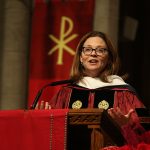
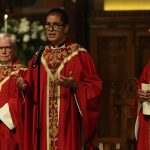
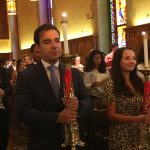
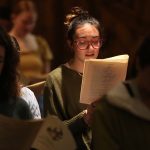
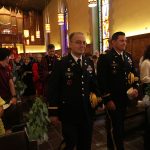
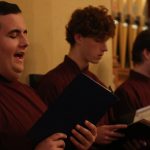
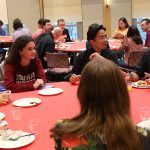
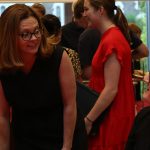
The Fordham community gathered on Sept. 11 to kick off the academic year at the annual Mass of the Holy Spirit on the Rose Hill campus.
President Tania Tetlow asked those in attendance at the University Church to think about the meaning of the ceremony, both current and historic.
“This is bigger than this particular moment, than this particular community,” she said. “When we do the Mass of the Holy Spirit, we perform the rituals that people just like us— students, faculty, staff—have performed for almost 500 years, of opening the semester of a Jesuit university.”
Tetlow told the students that the community gathered there on Sunday would be there for them along their journeys—both for their successes and when they hit bumps in the road.
“What tonight is about is telling you, above all, that in that work, in those choices, in those decisions you make—that you are loved by God, no matter what, for who you are, and that you are loved by Fordham, no matter what, for who you are,” she said. “We will wait with bated breath and hope you make the right choices. But we will be there for you when you stumble, when you learn, when you find a new path and a new way. And we want you to keep coming back to this community as a source of strength and above all, as a source of love.”
]]>“Father Sosa is both deeply spiritual and entirely pragmatic. He comes from higher education, so he understands the challenges and opportunities we face,” said Tetlow. “We talked and laughed about all sorts of things, but especially about how we can deepen our Jesuit mission, even as we transition to lay leadership.”
A Personal Endorsement of President Tetlow
The meeting between Father General Sosa and Fordham’s newest president—the first woman and layperson to hold the position—was important for Fordham, said John Cecero, S.J., vice president for mission integration and ministry at Fordham.
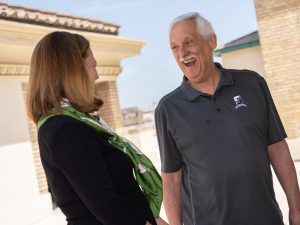
“From the perspective of the Society, it was probably the strongest endorsement of Tania and her leadership that one could possibly get,” Father Cecero said.
The introduction between the two leaders is not unusual. Over the past two centuries, other superiors general have established relationships with Fordham and also visited the University campus. In 2013, Father General Sosa’s predecessor, Adolfo Nicolás, S.J., celebrated Mass at the University Church. In 1991, Peter Hans Kolvenbach, S.J., delivered the homily at the baccalaureate Mass and the benediction at commencement the next day. In 1966, Pedro Arrupe, S.J., served as the featured speaker at a special academic convocation celebrating Fordham’s 125th anniversary. Finally, and perhaps most significantly, past Fordham president Vincent O’Keefe, S.J., was elected assistant ad providentiam to Father General Arrupe in 1975 and later served as vicar general of the Society.
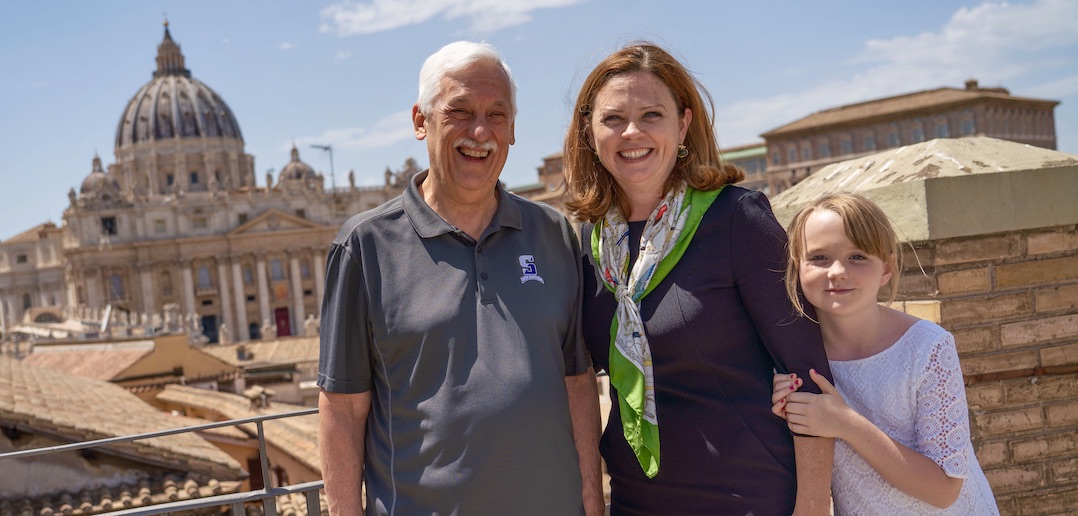
From Father General Sosa’s Perspective: Challenges in Higher Education
The luncheon between Father General Sosa and Tetlow took place in his private dining room in the Jesuit Curia, where they were joined by Father Cecero, who has met Father General Sosa several times in his past role as provincial of the Jesuits’ USA Northeast Province. Armando Nuñez Jr., chair-elect of Fordham’s Board of Trustees; and Douglas Marcouiller, S.J., regional assistant for the USA Assistancy at the Jesuit Curia, also joined the meeting.
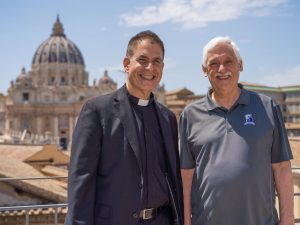
Father General Sosa was elected as the 31st leader of the Jesuits in 2016. He has previously served in leadership positions for the Society, including director of a research and social action center and the Society’s provincial superior in his native Venezuela. He also participated in the Society’s 33rd general congregation, where he served as the youngest delegate at 34 years old. He is a scholar, political scientist, and former educator.
Over a traditional Italian meal, Father General Sosa and the Fordham leaders discussed topics both light and heavy, including challenges facing Jesuit schools today, said Father Cecero.
“The traditional mission paradigm emphasized the delivery of a body of truths and traditions to the university community. Father General challenged us to shift that paradigm, emphasizing instead the need to engage in encounter and dialogue with all university constituents, so that out of that fruitful exchange, we will come together to a much richer understanding of who we are and why we exist,” said Father Cecero.
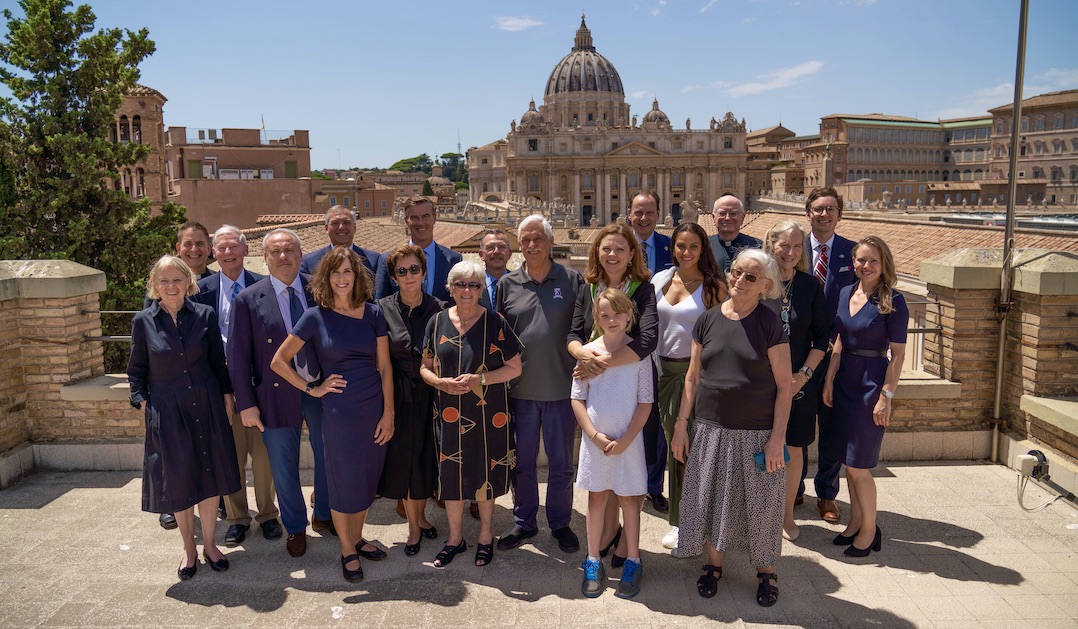
An Ongoing Connection with Jesuit Leadership
After the luncheon, Father General Sosa met the entire Fordham delegation on the Jesuit Curia’s rooftop, where he greeted each person and then posed for a group photo in front of St. Peter’s Basilica. Then the delegation toured the Curia itself, including its chapel that contains the relics of Jesuit saints.
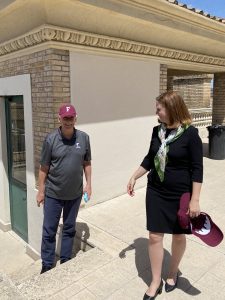
Nuñez emphasized that establishing relationships with leaders like Father General Sosa is important in maintaining Fordham’s Jesuit identity.
“As someone who is a big believer in the power of Jesuit education, I thought it was an incredible experience to be able to interact in person with the leader of the Jesuits,” said Nuñez, who graduated from the Gabelli School of Business. “Now that we no longer have a Jesuit president, it’s more important than ever for the board and the lay leadership of the University to be aware of the Jesuit mission and identity. I hope that connecting with the Jesuit leadership continues to be an ongoing tradition.”
This article is part of a series of stories about the Rome pilgrimage. Read the original full-length story here.
]]>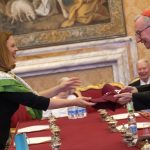
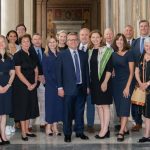
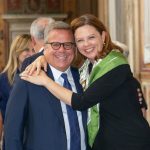
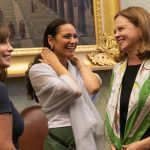

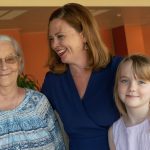
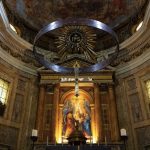
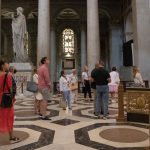
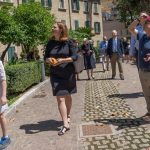
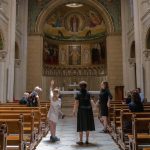
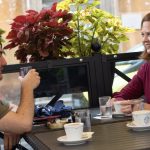
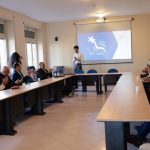 One week before taking the helm as the 33rd president of Fordham, Tania Tetlow accompanied a University delegation to Rome—a city with deep ties to the Jesuits—to mark the 500th anniversary of the spiritual conversion of St. Ignatius Loyola. In a weeklong trip in late June, the group walked in the footsteps of St. Ignatius—the founder of the Society of Jesus—who spent 15 years in Rome. They also met several Vatican officials and the superior general of the Jesuits.
One week before taking the helm as the 33rd president of Fordham, Tania Tetlow accompanied a University delegation to Rome—a city with deep ties to the Jesuits—to mark the 500th anniversary of the spiritual conversion of St. Ignatius Loyola. In a weeklong trip in late June, the group walked in the footsteps of St. Ignatius—the founder of the Society of Jesus—who spent 15 years in Rome. They also met several Vatican officials and the superior general of the Jesuits.
“It was an extraordinary chance to come to Rome, to the center of the church,” said Tetlow, who went on the pilgrimage with family, trustees, and alumni. “It was a chance for the board and other friends of Fordham to commit to the mission and to understand the broader global church, and it was pretty special inspiration for me as I begin the work ahead.”
A Pilgrimage to the ‘Heart of the Church’
The pilgrimage was inspired by the life of Iñigo de Loyola, a young soldier from a noble Basque family in the 1500s who once sought fortune and fame. When his leg was shattered by a cannonball in battle, he spent months recovering at his family home. It was during this crucial time that he began learning about Jesus and the lives of the saints. These stories and this period of discernment in recovery inspired his spiritual conversion. He decided to dedicate the rest of his life to the service of God and humankind.
Iñigo de Loyola, now known as St. Ignatius, went on to co-found the Society of Jesus in 1540. He and his religious brothers made their first home in Rome, where they lived in a small house between what is now the Piazza di Spagna, the “Spanish Steps,” and the Piazza del Popolo. Today, the Society of Jesus is the largest male religious order in the Catholic Church.
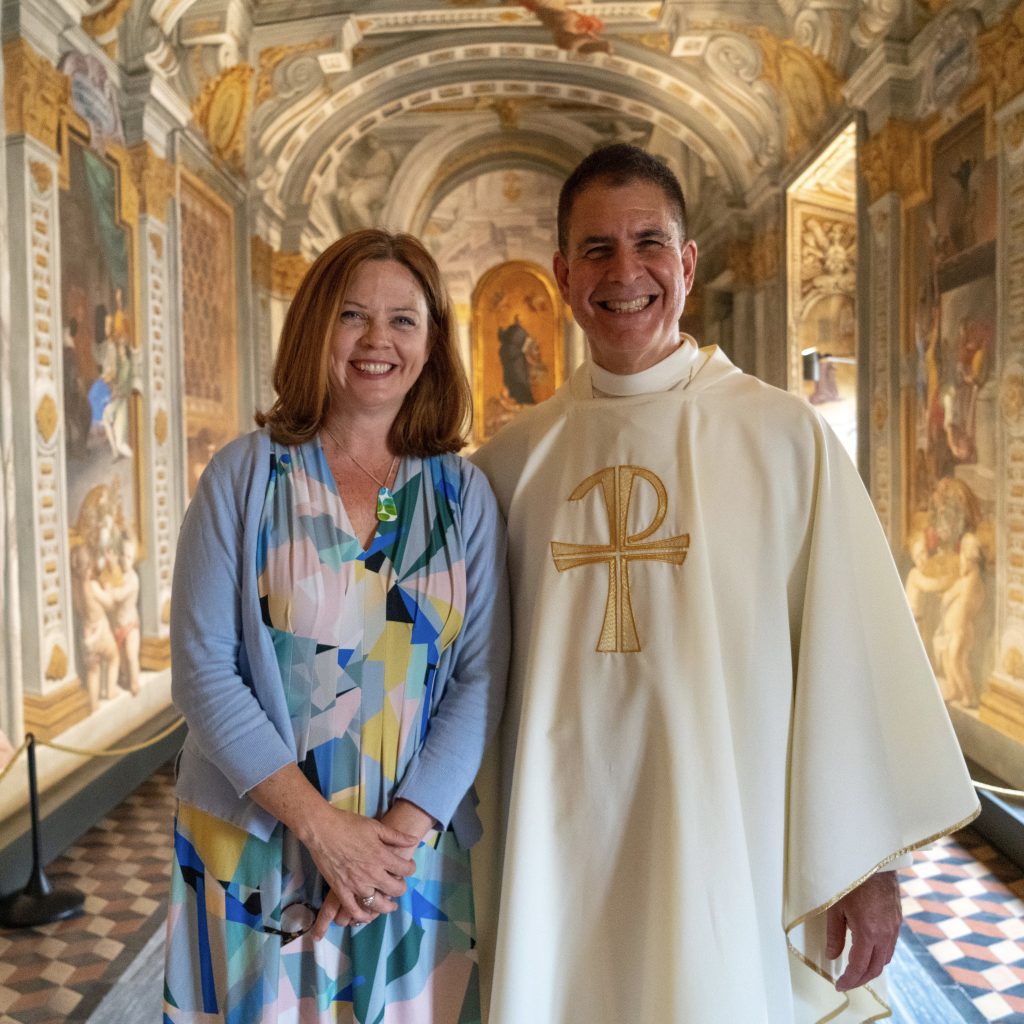
In honor of the 500th anniversary of St. Ignatius’ conversion, Jesuit communities across the world have been participating in a yearlong celebration, the Ignatian Year, beginning on May 20, 2021. Fordham has hosted celebratory events since last spring and will continue the celebration of St. Ignatius and his legacy until July 31, 2022, the Feast Day of St. Ignatius Loyola.
The Fordham trip to Rome served as the highlight of the yearlong celebration, featuring the University’s new leader, Tetlow: the first layperson and woman to lead the Jesuit University of New York.
“The timing of this trip couldn’t have been better as we transition now to our first lay president. It reinforces our responsibility as trustees to ensure the awareness of our Jesuit ideals, mission, and identity, and it’s our firm belief that through all of this, we can be—even with a lay president—more of a Jesuit university than we were previously,” said Armando Nuñez, GABELLI ’82, chair-elect of Fordham’s Board of Trustees.
The pilgrimage was also a “special” experience for the nearly two dozen members of the Fordham community who traveled to Rome, said John Cecero, S.J., vice president for mission integration and ministry.
“Coming here to the heart of the church, to have these conversations and to generate that awareness, was so special,” said Father Cecero. “To come here and walk in the steps of Ignatius, visit the sites that were so important to him, and meet the leaders of the church has been so precious.”
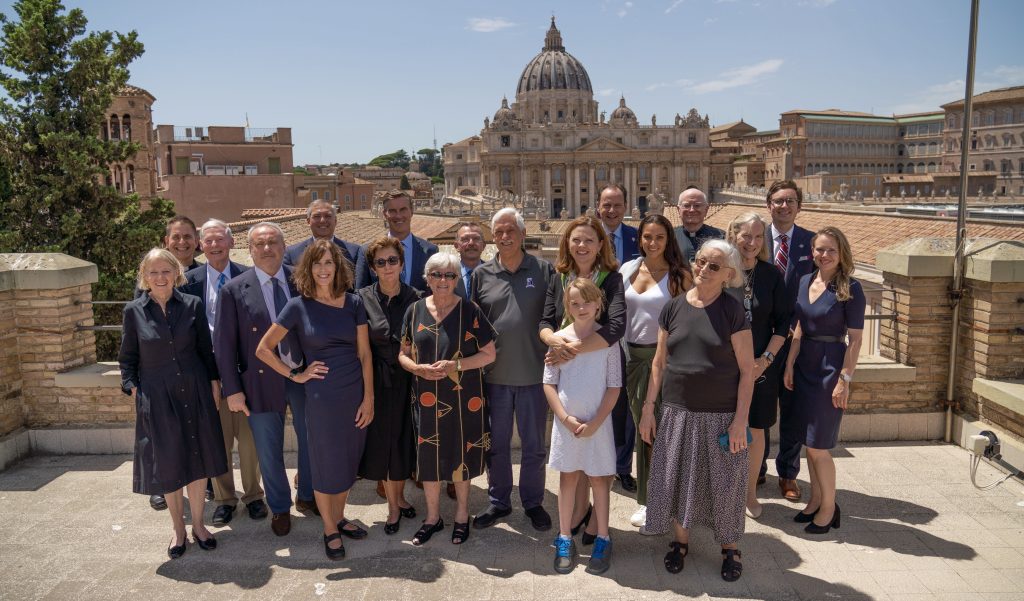
Exploring the Life and Home of St. Ignatius
On the first day of the trip, those who were fortunate enough to escape the effects of jet lag explored the beginnings of Christianity in Rome. They first visited the Roman Forum, the ruins of ancient government buildings, where they learned about the Roman context of early Christianity with an archaeologist. Then they visited the Basilica of San Clemente, a set of three tiered churches from the 1st, 4th, and 12th centuries, featuring detailed Christian mosaics.
The next day, the Fordham delegation immersed themselves in the life of St. Ignatius. In a series of guided tours, they explored the Santa Maria Maggiore, where St. Ignatius said his first Mass; the Gesù, the first Jesuit church in Rome that became the final resting place for St. Ignatius; and the Church of St. Ignatius.
“The Church of St. Ignatius is a beautiful and central place for us, not only because it contains the remains of the saints Aloysius Gonzaga, John Berchmans, and Robert Bellarmine, but also the architecture, art, and ceiling of the Jesuit artist Andrea Pozzo,” said Father Cecero. “All of this speaks to the Jesuit emphasis on integrating art, science, and beauty as an expression of God’s creation and as a way to reflect back to God our gratitude for his creation and the beauty that surrounds us.”
In a private tour, Tetlow and the Fordham delegation also explored the building where St. Ignatius directed the Society of Jesus as their first Superior General. It was here that he wrote the Constitution of the Society of Jesus, as well as handwritten letters to Jesuits who lived across the world.
In a small room, Father Cecero held a group liturgy and Tetlow, a professionally trained opera singer, sang the “Salve Regina.” Later that afternoon, they visited the Basilica of St. Paul Outside the Walls, the church where St. Ignatius and his early companions made final vows after the founding of the Jesuit order.
“St. Ignatius is my saint,” said Ignacio Fernández de Lahongrais, GABELLI ’87, whose great-uncle, father, and son all share the same first name. “It was very emotional to have Mass where St. Ignatius gave Mass. It was also absolutely wonderful to be where he lived and to learn more about his life and what he stood for.”
An Inspiring Message From the Vatican Prefect for Catholic Education
On the third day of the trip, the Fordham delegation traveled to the Vatican City, where they met Cardinal Giuseppe Versaldi, Vatican prefect for Catholic education, and Monsignor Guy-Réal Thivierge, secretary general of the Pontifical Foundation Gravissimum Educationis.
In an address to the Fordham delegation, Cardinal Versaldi discussed the importance of teaching about an inclusive faith through Catholic education. He emphasized that schools should maintain their core Catholic values, but continue to respect and welcome people from all walks of life. In addition, he applauded Fordham for its quality of education in a modern world.
“I’m sure you will continue this communion with the church, keeping your autonomy and your independence, but also the capacity to work together and to offer a contribution to a new world,” Cardinal Versaldi, who prompted the Society of Jesus to create the Mission Priority Examen, said to the Fordham delegation.
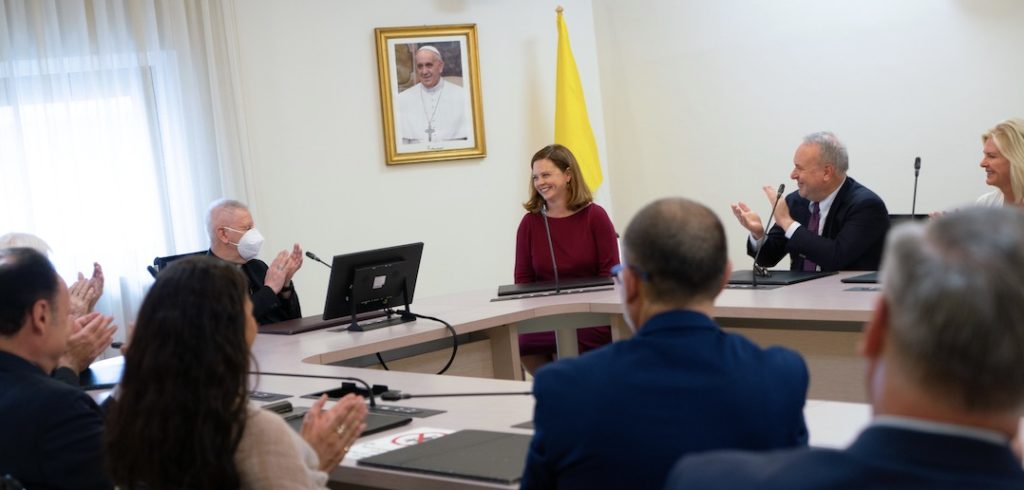
The cardinal’s message was inspiring, particularly for those who grew up in a period that was less inclusive, said Elizabeth “Betty” A. Burns, FCLC ’83, a former trustee who was raised Catholic. The cardinal’s speech was also surprising in a positive way, said Robert Smolens, husband to Donna Smolens, FCRH ’79, GSAS ’81.
“I thought he would be a little more dogmatic and concerned about, as he put it, this secularization that’s going on in the world. It’s not the same place that it was 30, 40 years ago, when my wife and I were in school,” said Smolens, who was raised in a Jewish household and is married to a Catholic. “But he welcomes the challenge of 2022, and that’s what we need to still have a great Catholic university.”
The overall message from the cardinal and his associates is important to Fordham and its mission, said Kim Bepler, a University trustee and philanthropist who earned an honorary doctorate from Fordham this May.
“It was so inspiring and forward-thinking to hear what the monsignor and the cardinal had to say about the Catholic identity, the mission of the Jesuits, and that we don’t lose sight of the mission of Fordham,” said Bepler. “We are inclusive, and we are also welcoming. As the educational model changes, we change—and it’s for the better.”
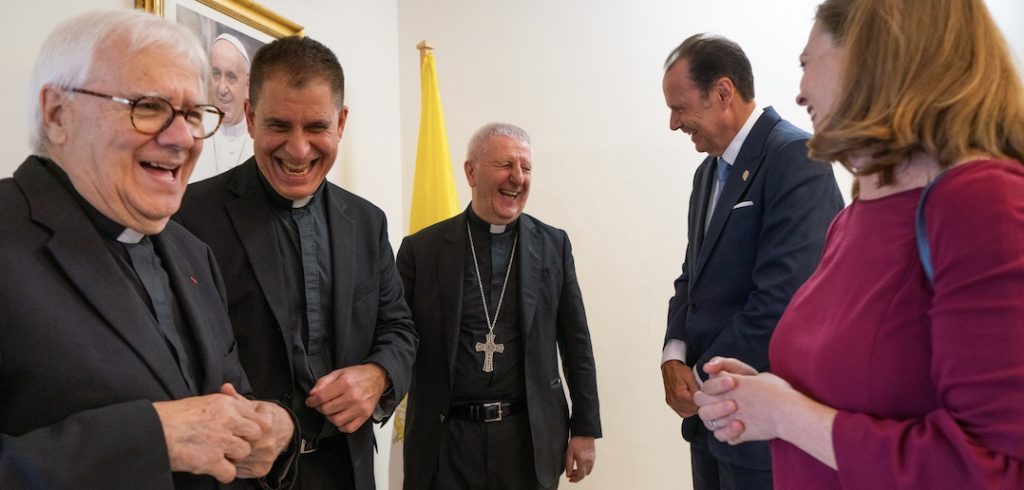
Meeting the Vatican Secretary of State
On their final day of the trip, the delegation met Cardinal Pietro Parolin, Vatican secretary of state, in the heart of Vatican City. The Fordham delegation awaited the cardinal in the Apostolic Palace, the official residence of the pope, where they sat in ornate chairs and were surrounded by elaborate paintings. For a few minutes, the room was silent except for hushed whispers and the continuous ticking of a grandfather clock. When the cardinal arrived from an entrance in the corner of the room, everyone immediately rose from their seats.
In a 20-minute speech, the cardinal echoed the words of his associates and wished the Fordham delegation well on their trip.
“It is my hope that on your pilgrimage to Rome, your experience of Christian sites and your visits to places associated with the life of St. Ignatius will prove inspiring and sustain you in joyful and hope-filled love for Christ and one another,” Cardinal Parolin said to the Fordham delegation.
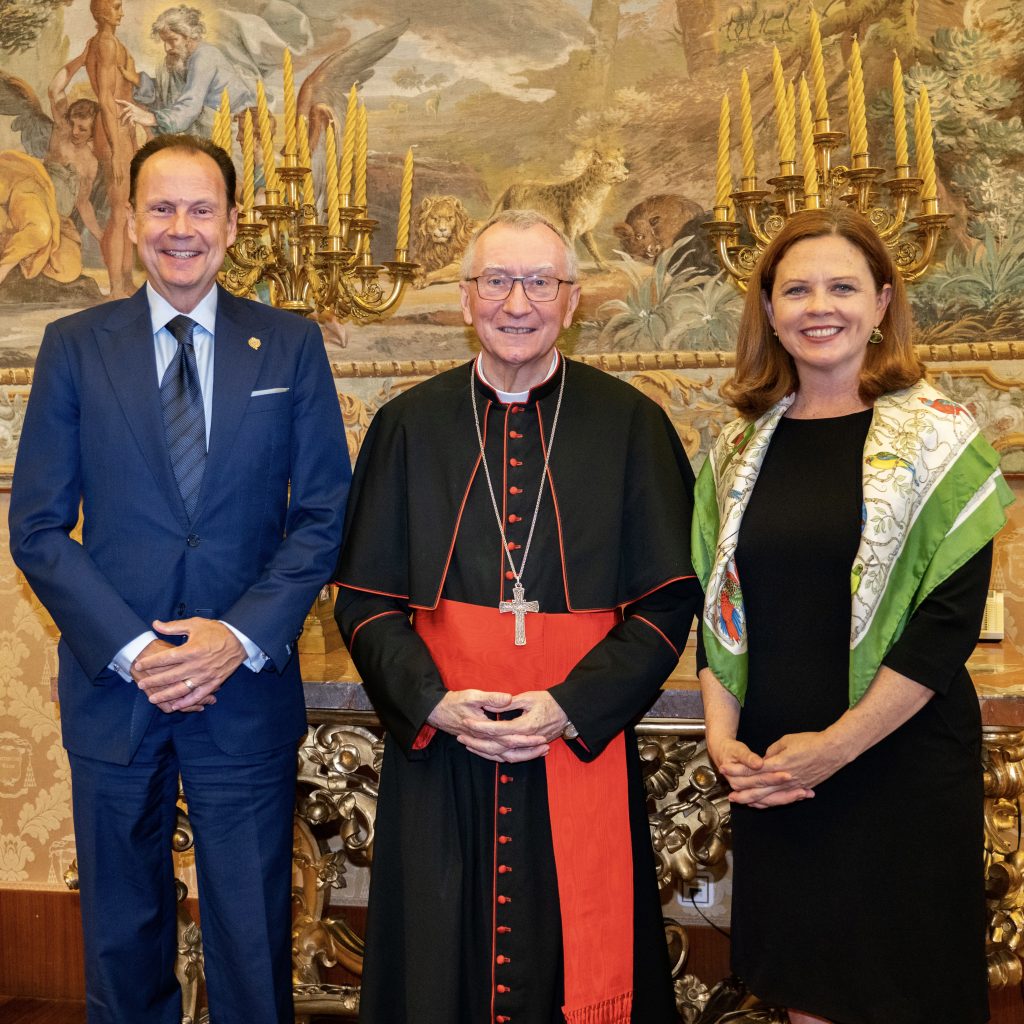
Tetlow thanked him for his words and offered her own thoughts on the future of Catholic education. Historically, Catholic schools and universities have offered opportunities to students from all different backgrounds, including immigrants and first-generation students, she said. Their core mission has been supported by not only priests, but the lay people, she added.
Now, in a time when the U.S. and the American Catholic Church are increasingly divided, Fordham’s Catholic identity offers a reminder of our common values and the need to serve the common good, she said. She also acknowledged that Fordham serves students from many faiths, increasingly those who have no religious background. It is important that the University does not “preach to the choir,” but encourage respect for the church, the Catholic faith, and people from all walks of life, she said.
“We ask students to put aside their own ideas and be willing to think of new ideas and to embrace faith and spirituality, and we teach that openness by modeling it ourselves,” she said to Cardinal Parolin. “It is not an easy task right now, but we work very hard to make that manifest at Fordham, which is one of, as you described, the finest Catholic universities in the world. And so it is a great responsibility for me—for this board, for this community—to do that well, and it is the privilege of our lives to serve the church in this way.”
At the end of their exchange, Tetlow gifted Cardinal Parolin with a Fordham baseball cap. The cardinal immediately placed it over his red skullcap and waved at the staff photographer, while the Fordham delegation laughed appreciatively. As the delegation filed out of the room, he handed each member a blessed rosary.
“I love the fact that we’ve got more Fordham baseball caps wandering around Rome,” Kim Bepler later said during a car ride in Rome.
“We did leave one for the pope, so maybe we’ll see him appear on the balcony someday with a Fordham cap on,” said Father Cecero, chuckling. (Pope Francis was unfortunately unable to meet with the Fordham delegation.)
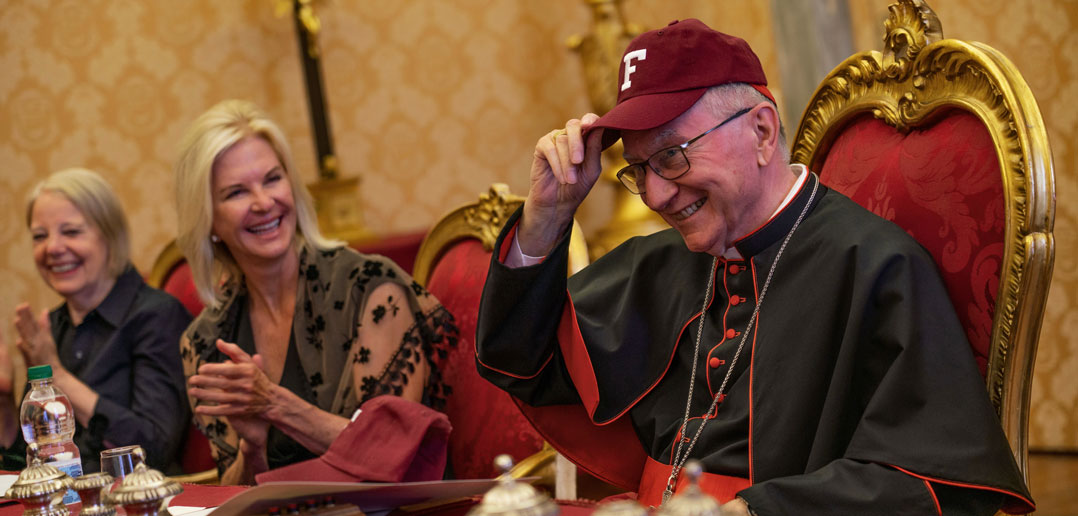
A Visit to the Jesuit Headquarters to Meet the Superior General
Later that afternoon, the Fordham delegation met Arturo Sosa, S.J., superior general of the Society of Jesus, on the rooftop of the Jesuit Curia in Rome—the headquarters of the Jesuits.
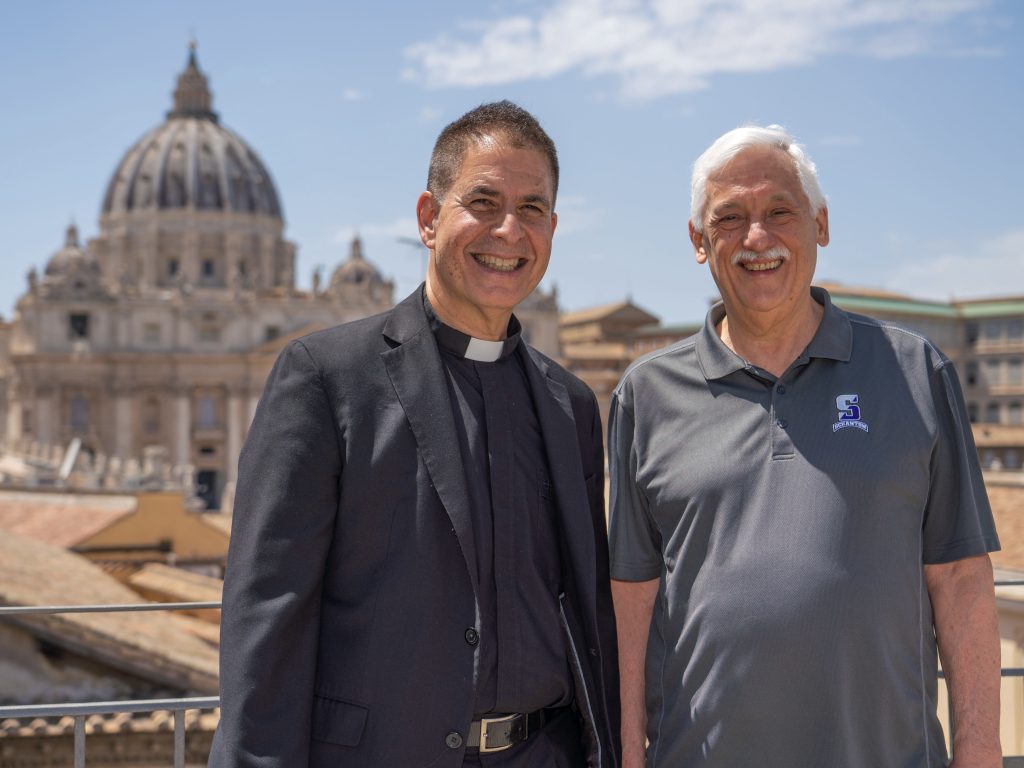
“It was a real treat to meet the Father General. He was wise and wonderful and a lot of fun,” said Tetlow, who shared a private meal with him. “[We talked about] matters big and small: the transition to lay leadership, the state of Jesuit universities in the U.S. and around the world, and opportunities for all of us to partner more with each other across national borders.”
Afterward, the Fordham delegation toured the Curia, including the chapel, gardens, and the dining room, where they sampled freshly picked fruit from the Curia’s own backyard.
In the delegation’s final outing as a group, Father Cecero held Mass at Sant’ Andrea al Quirinale, the third Jesuit church constructed in Rome, where young novices once studied. People offered prayers—for the people of Ukraine, for Tetlow and her family as they start their new journey at Fordham, and for Father Cecero, who spearheaded the pilgrimage.
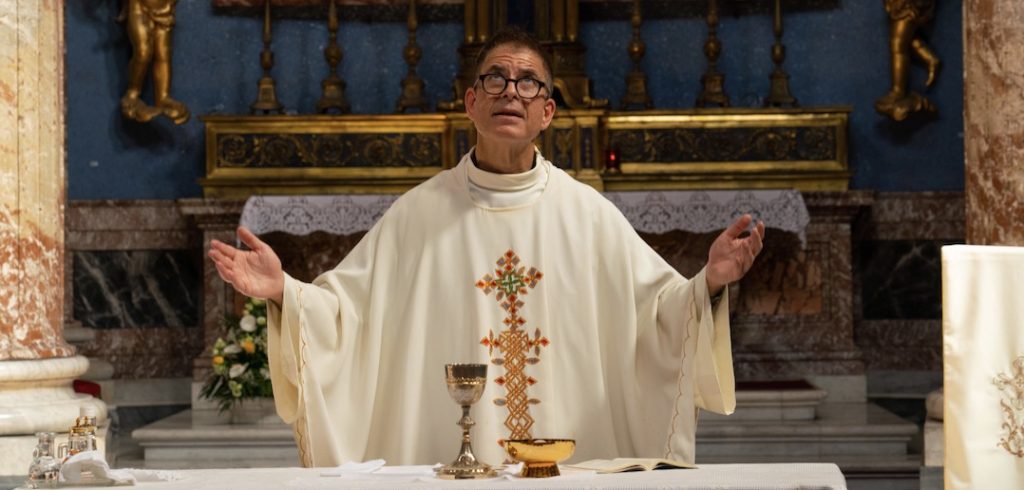
Returning Home with A New Vision for Fordham
Each Vatican official from the pilgrimage affirmed the importance of “service, engagement, and encounter”—three concepts that are critical to the mission of Fordham’s Center for Community Engaged Learning, said the center’s executive director, Julie Gafney, Ph.D., who was part of the Fordham delegation.
“This is so crucial because this is the work that the center does at Fordham. We often talk about our mission internally at Fordham, but to hear these leaders express that this is the bedrock on which our educational tradition is founded—and also an area for innovation in education—was so powerful and something I want to bring back and continue to grow at Fordham,” said Gafney.
Gafney said that many Jesuit schools have become strong research institutions, but it’s important for them to remember the roots of the Jesuit tradition: educating young people, especially those from underprivileged backgrounds.
“Our center offers tutoring, mentorship, college access programming, and mental health services to youth-serving nonprofits and local schools in partnership with faculty and students. I’d really like to scale and increase those forms of engagement, since they can be deeply impactful and align powerfully with our mission,” said Gafney, who also oversees programs like Urban Plunge and Global Outreach. “I’d like to have 1,000 Fordham students serve as tutors and mentors. It’s doable. It’s needed. And I think it could be really powerful—both for the middle and high school students and the Fordham undergraduates.”
Building Relationships Abroad
On the last day of the pilgrimage, several members of the Fordham delegation visited Villa Nazareth, a Vatican-affiliated residential college for talented students from low socioeconomic backgrounds in Italy, where they toured the facilities, interacted with present students, and discussed an invitation from Cardinal Parolin to establish a partnership with Fordham.
The school was established in 1946, one year after World War II ended, to help orphans reach their potential. Since then, Villa Nazareth has become a prestigious institution that educates and houses students, free of charge. The institution, managed by a nonprofit called the Comunitá Domenico Tardini Association, has received attention from many visitors, most notably Pope Francis in 2016, and is led by Cardinal Parolin.
The visit was an opportunity for Fordham to expand its global footprint and establish a new relationship with a school in Rome that shares the same mission.
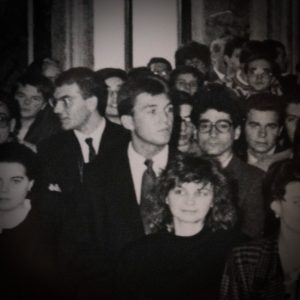
“The mission of our schools is to deliver cura personalis, and what you have described about what happens here is exactly that—to care for the whole student,” Father Cecero said, addressing administrators at Villa Nazareth after listening to a PowerPoint presentation about the school’s mission. “You’ve given us important seeds to ponder about how we can creatively work with you because we share a very common mission.”
The visit was also a homecoming for Roger A. Milici Jr., vice president of development and university relations at Fordham, who studied at Villa Nazareth in 1986 and 1987. On the wall of a campus building, Milici pointed to a black-and-white group photo of students from several decades ago, featuring his 21-year-old self. “It feels like yesterday,” he said.
Archbishop Claudio Celli, deputy president of Villa Nazareth, embraced the potential of a new partnership with Fordham.
“Your people can be here, and our people can go to Fordham,” Archbishop Celli said to the Fordham delegates in the room. “This is just the beginning—but we can see the future.”
This article is part of a series of stories about the Rome pilgrimage.
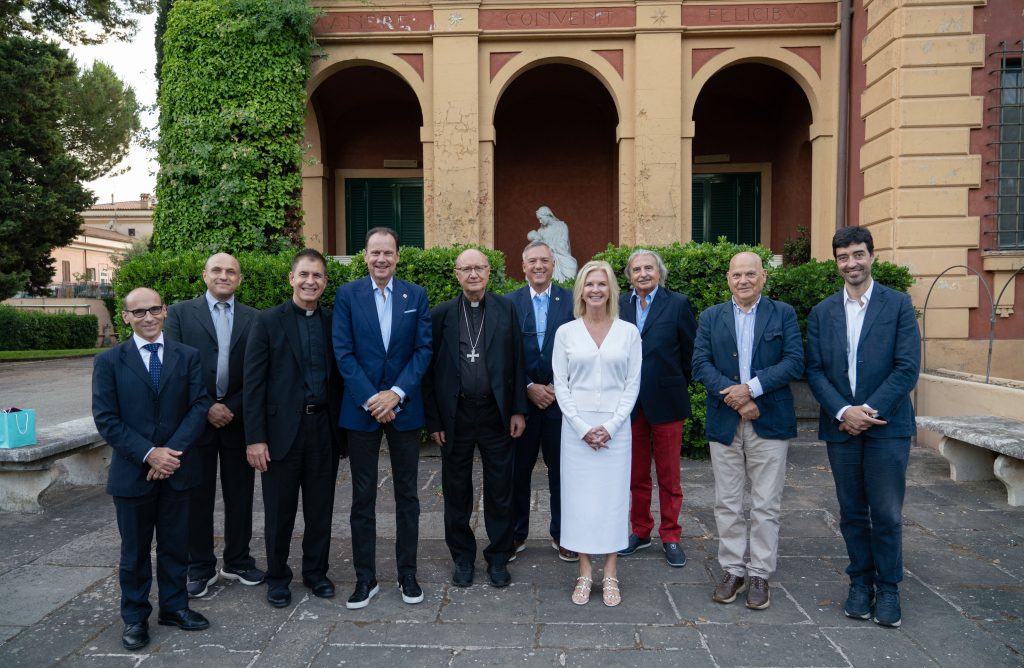
But when the 71,000-square-foot, four-story addition to the McGinley Center officially opens today, Feb. 1, it will introduce to the Fordham community a radically different sort of space, filled with places to relax, recharge, and connect.
Get Your Sweat On
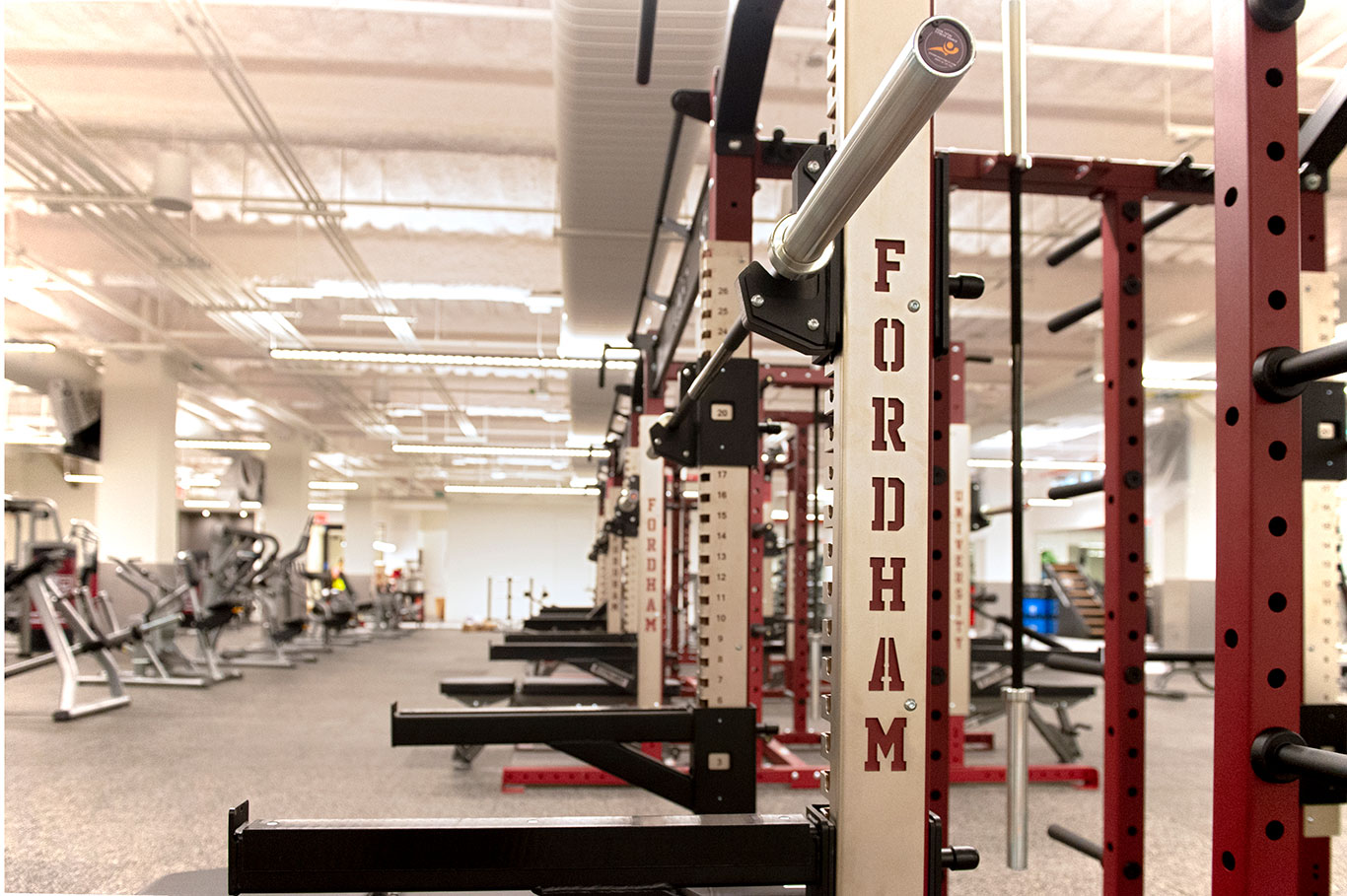
One of the highlights of this new building addition will be the expanded fitness center, which at 20,000 square feet occupies the lower level of both the new building addition and the existing McGinley Center. The brand new, brightly lit space, which is illuminated by both overhead lighting and sunlight from ceiling windows facing the front of the building, is dedicated to 100 pieces of state-of-the-art weight-training equipment. The existing space will continue to be used for cardio equipment, assuring shorter wait times. One of the newest pieces of equipment is a climbing simulator known as a Jacob’s Ladder. (The fitness center is currently operating at reduced capacity due to COVID-19 regulations.)
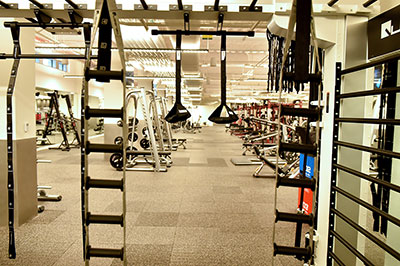
Eagle-eyed visitors heading to a newly offered yoga session in one of the two new classrooms might notice that the arches of the original McGinley Center have been left as unfinished concrete, not painted white like the rest of the wall. It’s a small, subtle touch meant to acknowledge the past, said Larry Peifer, the lead designer for architecture firm HLW International LLP. A similar sensibility influenced the choice of the new addition’s Corinthian granite façade, which is the same material on the outside of the Rose Hill Gym next door.
“We’ve kind of remixed Fordham’s architectural palate. We took these materials you see elsewhere, whether its Corinthian granite, limestone terrazzo, oak, or bronze, sampled them, and used them in a new way,” he said.
A Home Away from Home
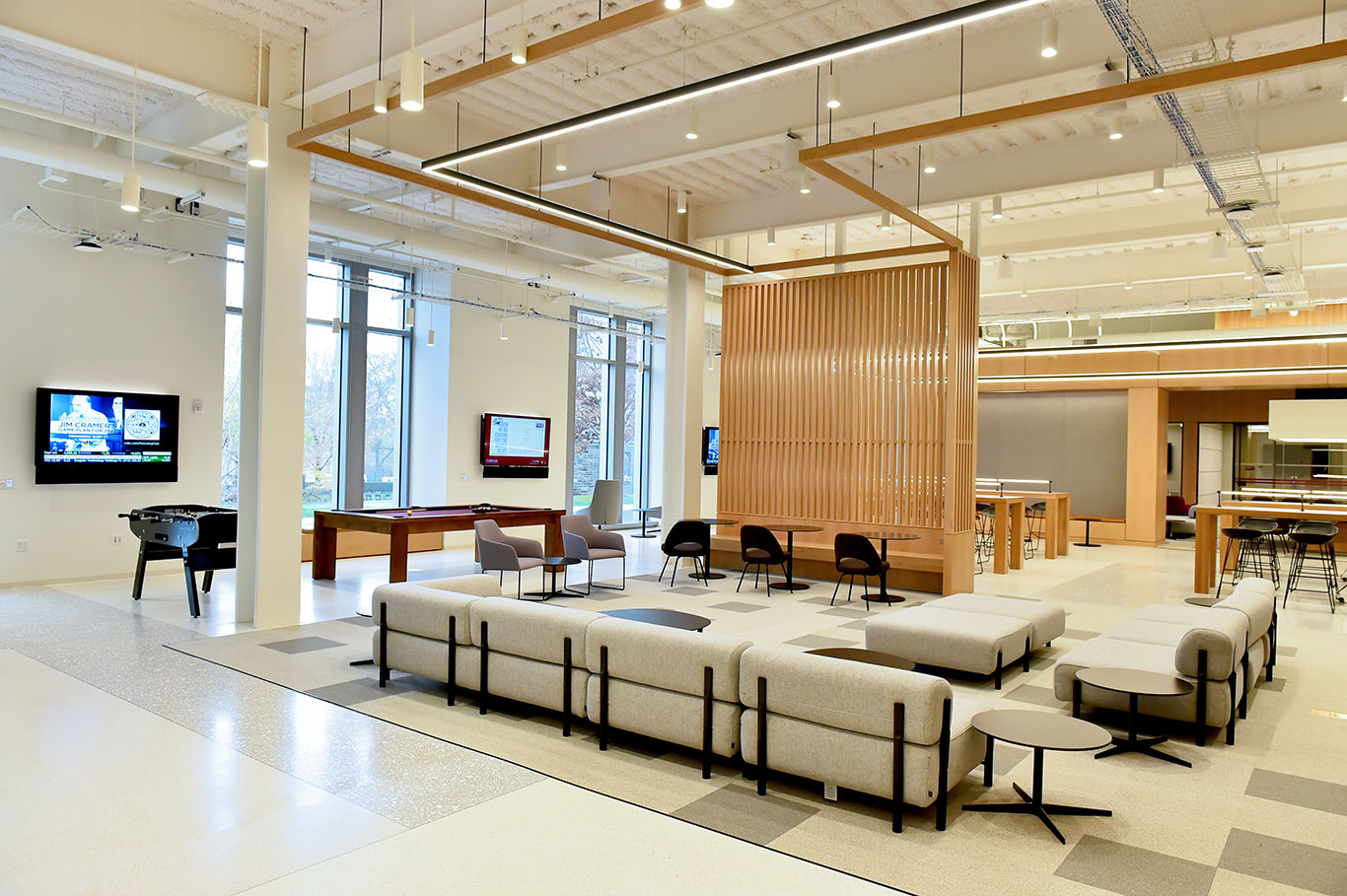
The first floor presents two distinctly different yet equally inviting common spaces: the student lounge and the gallery.
Boasting 17-foot ceilings, the lounge is an airy, semi-industrial space, with an unfinished concrete ceiling and exposed wiring above. The furnishings offer a mix of practicality and fun; sitting upon the terrazzo floor are tables, chairs, couches, a foosball table, and a pool table. Further on, a table large enough for a gathering of 16 is sectioned off by a dropdown ceiling; beyond that are private, glass-enclosed meeting rooms.
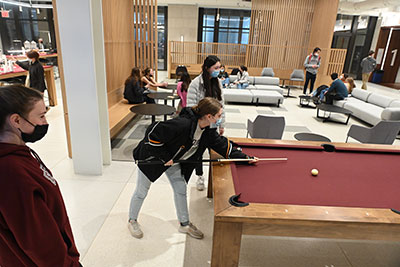
John P Gering, managing partner for HLW, said the goal for the 9,500-square-foot lounge has always been to make it feel like a place where resident and commuter students alike can mingle and relax.
“It feels less like a classroom environment. It’s very informal, there are lots of touchpoints for laptops and things of that nature,” he said.
The gallery, a multi-level glass-covered space linking together the addition with the existing McGinley Center, is open to the addition now. After the third phase of construction is complete, the walls will come down, and a newly refurbished

marketplace dining facility replacing the existing dining space will be seamlessly connected to the other spaces.
Its defining characteristic is natural light, which streams down over the two overhead walkways connecting the second floors of the new building addition and McGinley, past the 20-foot retractable movie screen hanging from the ceiling, and onto the floor and walls, where the stone engravings of the Stations of the Cross are embedded. At night, the engravings will be illuminated.
Career Services and Campus Ministry
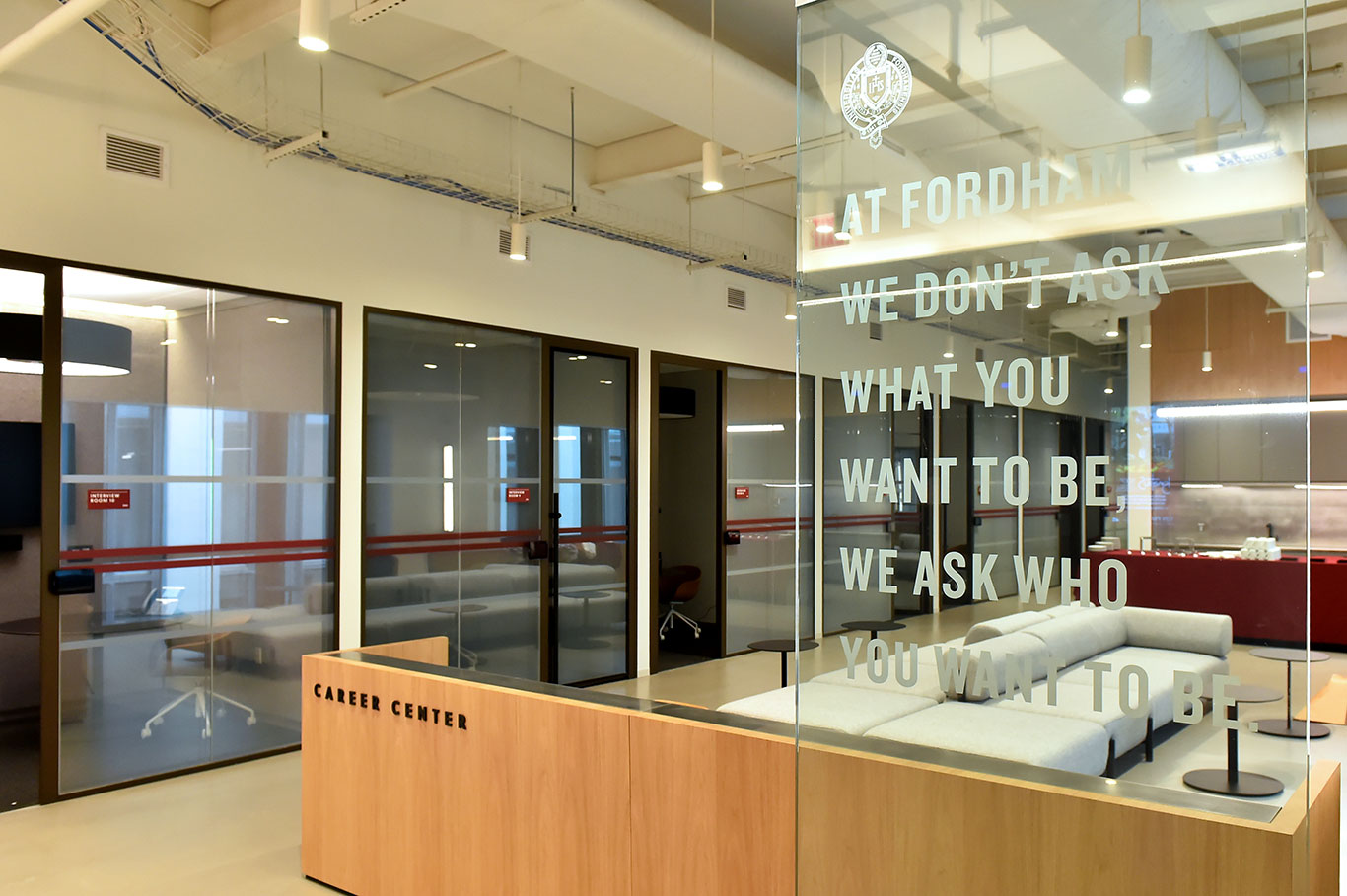
The second floor is shared by the expanded offices of the Career Center, Campus Ministry, and the Center for Community Engaged Learning.
The new Career Center space features a lounge with a rough-hewn ceiling similar to the student lounge that’s bathed in light from windows in the front of the building. Also included in the suite are a pantry and 10 interview rooms outfitted with noise dampening panels and electronic glass walls that can be turned opaque with a light switch. Career services director Annette McLaughlin said in a 2020 interview that it’s her intention that the department is “a destination, not a checklist,” for students.
“I want to create a career center for cura personalis. This is all about mind, body, and spirit as it relates to how you find your pathway in the world,” she said.
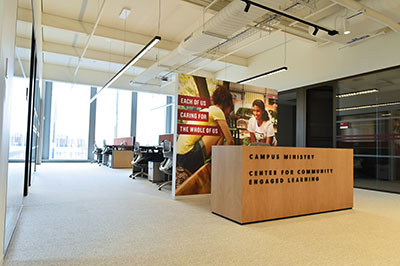
Next door is a hub for students’ quest for deeper meaning in their lives. In addition to offices, the Campus Ministry and the Center for Community Engaged Learning feature two reflection rooms, a room with a widescreen suitable for conferences, and several smaller spaces available for gatherings.
John Cecero, S.J., vice president for mission integration and ministry, said he’s excited to bring together two departments within the division that had previously been in separate spaces.
“There’s much more common space for people to use, and I think that will foster collaboration both between these two departments and with others within the University. That is a major goal for us,” he said.
A New Vista for a New Era
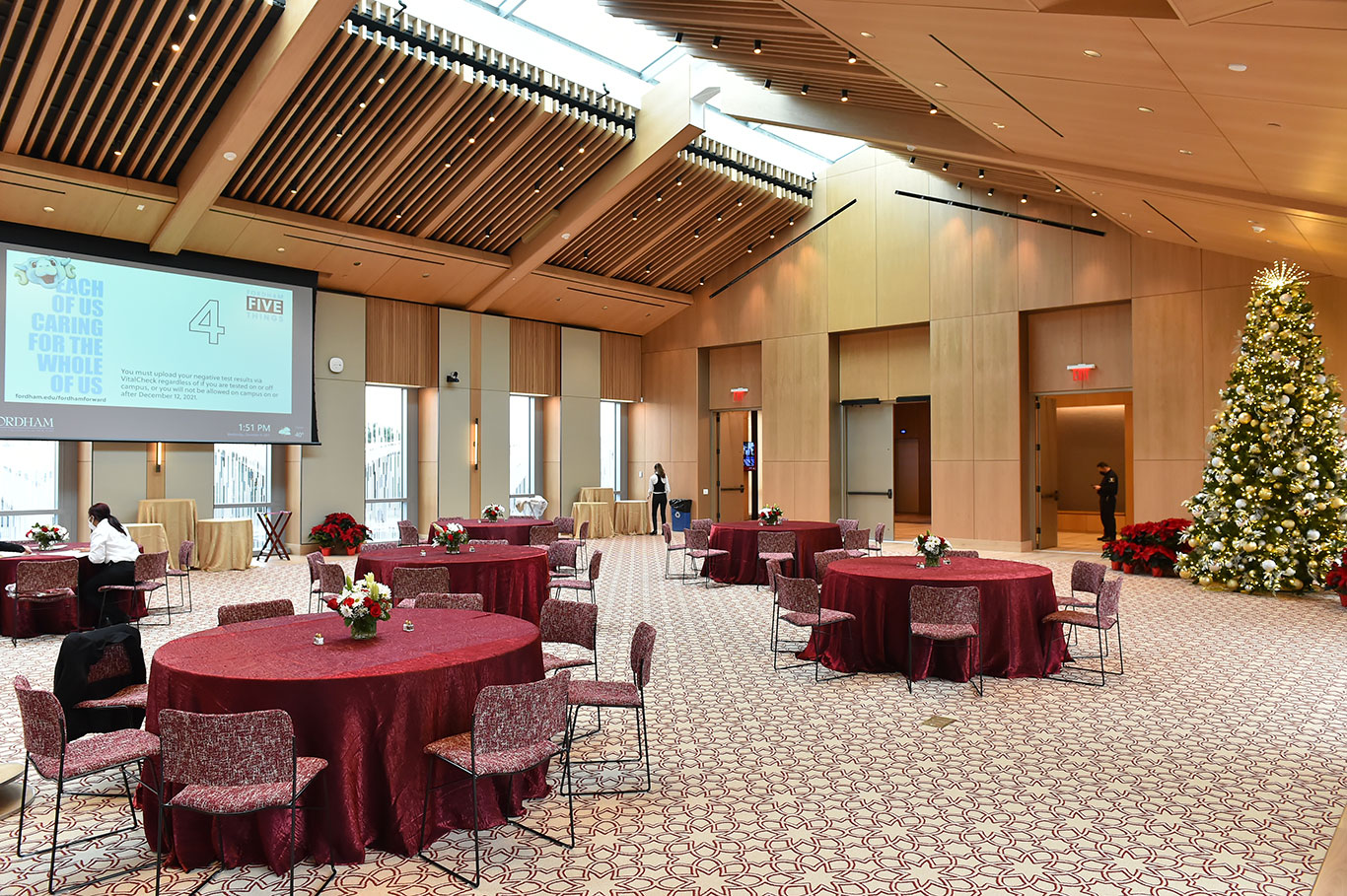
Arguably the most breathtaking view is from the top floor, where the 28-foot ceiling is open to the sky like the gallery next to it. The 4,390-square-foot multipurpose space also reflects Fordham’s Catholic identity, with the Stations of the Cross occupying a central place on the back wall. The views from the top floor—the New York Botanical Garden to the north, Bahoshy Field to the west, and Hughes Hall and Edwards Parade to the south—give a new perspective to a familiar locale. Embedded in the wooden drop-down ceiling are acoustic panels, audiovisual equipment, and darkening shades that can be easily deployed for presentations.
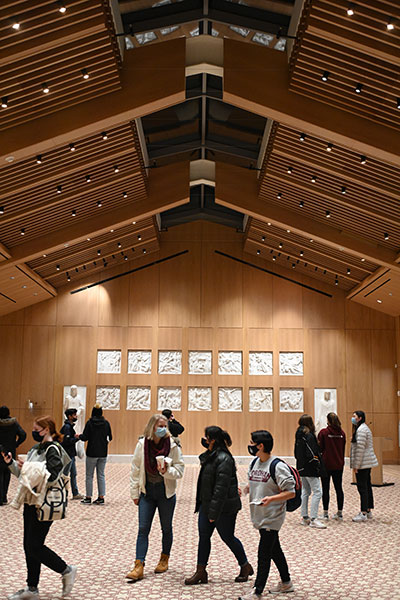
Gering said the space, which can accommodate as many as 196 people in the main room and 147 in another, smaller room, is part of the firm’s dedication to the neo-Gothic aesthetic of the Rose Hill campus. Traditional gothic buildings are built with a portal entry and a main entry next to a tower that leads to a large aisle connecting to an altar, he said. This will be the case when a glass arcade between the new building addition and the Rose Hill Gym is completed in the second phase of construction.
“As you enter the building, you enter next to a tower, which is a beacon on campus. Then you walk through the arcade, which is similar to the aisle in Gothic architecture, and rather than walking to an altar or chapel, you proceed up to the next level, which is this grand board room and multifunction room,” he said.
“This is shifting the heart of the campus. The idea is that it is truly a campus center that brings everyone together with amenities, gathering places, and wellness programs and spaces that respond to that. It’ll be the new landmark of the university.”
The new building addition is the first of three phases that the center will undergo as part of a radical transformation that will culminate in 2025. When finished, the entire project will reflect Fordham’s history while giving visitors a modern space to convene and relax.
“If it’s going to be a building that really feels like the University and is taking the University someplace new—but not someplace that it doesn’t recognize—it has to have a certain spirit and a poetic weight that feels contemporary,” Gering said.
“Fordham has such a strong history and rich personality; we didn’t want anything to feel like it was foreign.”
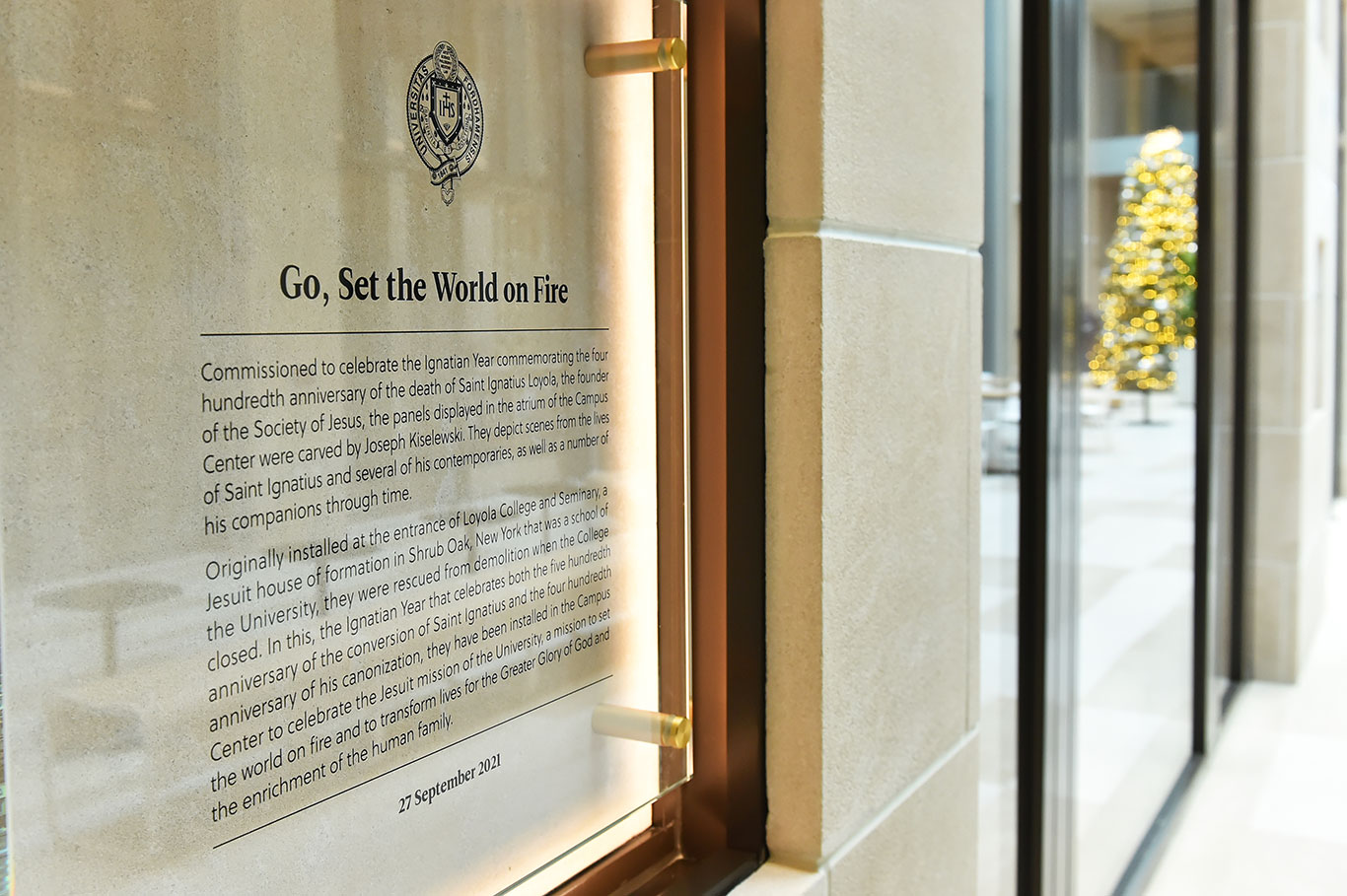
Q: Seven years ago you left your position as rector at Fordham to take over leadership of the newly combined USA Northeast Province of the Society of Jesus. What did you learn from your time that you’ll be bringing back to the University?
A: A large part of bringing together the New York and the New England provinces was to focus on the core features that united us. The different missions are all rooted in a common appreciation of how God labors in the world and through each of us, and our response is one of gratitude, love, and generosity.
Having been at Fordham for 15 years, I have a special interest in Jesuit higher education. What is unique about Jesuit higher education is that same spiritual foundation we’re focused on in the province. We’re in the business of not only preparing people for careers, but also informing how they see the world, how they orient themselves toward God and other people. No matter what profession they pursue, they put those gifts at the service of others, and especially the poor, the marginalized, and those members of society who are ignored or overlooked.
I think sometimes we forget to articulate that we’re not here only to introduce people to great ideas, but also to make them “men and women with and for others.” My role is to work with others in the University to keep our focus on why we are engaged in the business of Jesuit education here.
Q: What will be some of your biggest priorities?
A: One of my biggest priorities is working with the Board of Trustees. In 2013, I was asked to coordinate a meeting of the board chairs of 28 Jesuit colleges and universities with Father General Adolfo Nicolás, S.J. He said to them, ‘You are the leaders of the colleges and universities.’ In a legal sense, that’s absolutely true, but it’s also true in a mission sense. The board allocates finances and makes decisions that help people like me and others with overseeing and implementing the mission.
Another is faculty. I was a full-time member of the faculty for 15 years, so I know that faculty are very busy. The challenge is to help faculty have some time to reflect on that key question, ‘Why am I doing this in the context of a Jesuit university?’ That’s going to be through a series of talks and presentations, and through personal reflection and exploration. I’m working closely with Jim McCartin in creating initiatives that will include seminars and retreats.
We also want to expand the work that Lito Salazar, S.J., and campus ministry does. We want to serve the Catholic students and those who are interested in explicit religious practices, but there are others who I’m sure would benefit from programs designed to open them up to a spiritual worldview.
We also have the Center for Community Engaged Learning, which Dr. Julie Gafney just took over last year. They’ve increased the number of courses that are offered where faculty engage with students who participate in community engagement projects and integrate that work with academic work. It’s a wonderful opportunity to be of service to the poor and marginalized right here in the Bronx community.
David Gibson has been doing some wonderful talks, discussions, lectures, and seminars with the Center on Religion and Culture. I’m going to be working with him to expand that programming to include topics that would be of particular interest to younger people.
Q: Talk to me about life trap theory, which is your area of expertise in psychology. Is that going to play a part in how you approach your new role?
A: What gets in the way of productively focusing on mission are our personal, and you might say institutional, life traps. One of the life traps is overdependence. So for example, students or faculty might say, ‘Well, mission is the work of others and, I’ll let them do it.’ That’s kind of a trap because it’s shirking a responsibility that is really incumbent on all of us to participate in.
Q: This year is the Ignatian Year, which celebrates the 500th anniversary of the “cannonball moment” of St. Ignatius, the founder of the Jesuits. Why is Jesuit spirituality so important even after five centuries?
A: It was May 20 of this year that was the 500th anniversary of St. Ignatius being hit by a cannonball when he was a soldier. It was a turning point in his life because that wound literally laid him on his back, and during his convalescence, he started to read Lives of the Saints and started to think, ‘Maybe this whole ambition of worldly success is not that important—what’s really important is following Jesus Christ.’
What you might call the “cannonball moment” is what Jesuit education is all about. We’re not going to shoot students with cannonballs, but hopefully in the course of their time in a Jesuit school, their worldview gets shaken, maybe shattered, certainly rocked, and they get opportunities to radically rethink who they are, what they are, and what their purpose in life is, just as Ignatius did. So this year, we’re celebrating a focus on conversion and higher education. That’s the core mission.
Q: Does it feel more relevant given what a tumultuous time this is?
A: Pope Francis [who is a Jesuit]had something to say about that. He did a series of interviews recently and they were published in a book called Let Us Dream (Simon & Schuster, 2020). He says the pandemic is just like the cannonball for the whole world, and he hopes that the new normal will be a more radically transformed world, where we come out of it with a heightened awareness of the needs of others. He sees it as a fertile, if extraordinarily painful, moment for us.
]]>
Dear Members of the Fordham Family,
It gives me great pleasure to welcome back John J. Cecero, S.J., as Fordham’s new vice president for Mission Integration and Ministry, as of August 2, 2021. Father Cecero succeeds Michael C. McCarthy, S.J., who has held the post since January 1, 2016, under a slightly different title.
Please note that Father Cecero’s position title reflects a renaming of the Division of Mission Integration and Planning. It will now be titled the Division of Mission Integration and Ministry.
Father Cecero’s return to Fordham follows six years of service as the provincial of the USA Northeast Province of the Society of Jesus. He previously served at the University as an associate professor of psychology from 1998 to 2013 and is a tenured member of the psychology faculty here. He was a member of the Fordham Board of Trustees from 2008 to 2014, serving as chair of its mission and identity committee, and was the rector of the Fordham Jesuit Community from 2007 to 2013.
He received a Ph.D. in clinical psychology from the George Washington University in Washington, D.C., in 1996; master’s of divinity and theology degrees in 1988 and 1989, respectively, from the Weston Jesuit School of Theology (now the Boston College School of Theology and Ministry); and a bachelor’s degree in French and philosophy from Gonzaga University in 1982. He was ordained to the priesthood in June 1989.
Father Cecero completed a one-year clinical internship at the Boston VA Hospital and a two-year postdoctoral research fellowship in substance abuse treatments at Yale University’s Department of Psychiatry. He continues to give workshops and presentations on spirituality, addiction, mental health, and inspirational leadership to clergy and religious. He has published widely on lifetrap theory and practice, and he is the author of Praying Through Our Lifetraps: A Psycho-Spiritual Path to Freedom, a book-length guide published in 2002 by Resurrection Press. He is also the author of a series of audio presentations that were produced in 2009 under the title Spirituality, Psychology and Virtue: A Catholic’s Guide to a Flourishing Life.
As vice president for Mission Integration and Ministry, Father Cecero is responsible for the advancement of the Jesuit and Catholic mission of the University, in collaboration with other departments and offices across the University. In this role, he oversees the Office of Campus Ministry, the Center for Community Engaged Learning, and the Center on Religion and Culture.
I want to thank Father McCarthy for his long and transformative service as vice president for Mission Integration and Planning—the first person to serve in that expanded role. Father Mick, as most of Fordham knows him, has been a steady presence and a good friend. He is a well-liked and highly respected colleague, and we will miss him greatly. He will be taking a one-year sabbatical before moving on to a new assignment at the request of his provincial.
In Father Cecero we have a leader of intellectual substance, strong faith, and deep understanding of the human condition. He is an accomplished academic, administrator, and author, and a highly regarded psychotherapist. I look forward to working with him on the cabinet for his wise counsel and warm collegiality, and I believe he is exactly the right choice to lead Mission Integration and Ministry following the turbulent academic year we have just completed. I know you all join me in giving him a warm welcome back to Fordham.
Sincerely,
Joseph M. McShane, S.J.
]]>
Father O’Hare succeeded James C. Finlay, S.J., on July 1, 1984, to become the 31st president of Fordham University. He held that position for 19 years, making him the longest-serving president in Fordham’s history when he stepped down on June 30, 2003. His tenure marked a period of dramatic growth for Fordham: Applications soared in number; the student body grew academically stronger and more diverse; residential and academic space expanded; and the University exceeded the goal of its first comprehensive fundraising campaign, the crowning achievement of which was the creation of the William D. Walsh Family Library on the Rose Hill campus.
“Having served as Fordham’s president for some time—though not as long as Father O’Hare—I have some insight into, and a deep appreciation for, how gifted he was as a leader, a communicator, and a pastor,” said Joseph M. McShane, S.J., who succeeded Father O’Hare as president of Fordham. “He placed all of his considerable intellect, integrity, and vision in service of the University, and in doing so transformed Fordham into a powerhouse of Jesuit education. We will miss his wisdom, steady counsel, and warm wit.”
Robert D. Daleo, GABELLI ’72, chair of the University’s Board of Trustees, said the Fordham community owes Father O’Hare “a debt of gratitude for his long and singular service.”
“Father O’Hare led the University for 19 years, and despite some tough financial times, began Fordham’s rebirth as a national university,” he said.
Bronx Roots
A bit of an outsider to academia, Father O’Hare was working as the editor in chief of America, the Jesuit journal of opinion, when he was recruited for the presidency by Fordham’s Board of Trustees.
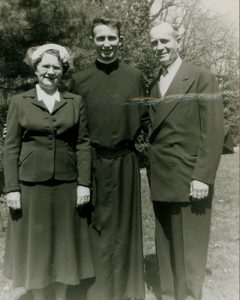
But the son of first-generation Irish Americans was hardly an outsider to Fordham, the Bronx, or to Catholic education. He was born on February 12, 1931, to Joseph, a New York City mounted police officer, and Marie, a schoolteacher, who raised their family in the close-knit Irish community of Tremont, just two miles from the Rose Hill campus. He attended Regis High School in Manhattan.
In a video tribute to Father O’Hare when he received the Fordham Founder’s Award in 2003, friends, teachers, and siblings recalled the young Joe O’Hare as a well-loved classmate with an easy demeanor, a straight-A student, and a natural storyteller. Although his exploratory forays into theater and basketball at Regis met with success, it was the priesthood that ultimately called to him: Upon graduating from high school in 1948, he joined the Society of Jesus.
Jesuit Formation
That decision, Father O’Hare told The New York Times, was largely inspired by the work of John Corridan, S.J., and the labor priests of the 1940s New York waterfront. “It’s not an otherworldly kind of spirituality,” Father O’Hare said of the Jesuits’ active faith. “It’s the kind very geared to involvement in the present time.”
The young Jesuit-in-training was sent to the Philippines, where he earned his bachelor’s and master’s degrees at Berchmans College in Cebu City. From 1955 to 1958 and again from 1967 to 1972, he served on the faculty at Ateneo de Manila University.
Edmundo Martinez, S.J., recalled being a student of Father O’Hare’s in the 1950s.
‘Those were heady days of youth’s idealism for the search of truth, and goodness, and beauty—ideals that rubbed off on us principally, for myself at least, from Joe O’Hare,” said Father Martinez, co-founder, chaplain, and teacher at the Ingenium School in the Philippines. “Like Socrates and his friends, we would sit around in class and discuss such topics as the medieval universities, with Joe leading us on to ever deeper levels and ever wider ranges of meaning.”
Between teaching posts, Father O’Hare returned to the United States, earning licentiate degrees in philosophy and theology in the early 1960s from Woodstock College in Maryland and a doctorate in philosophy from Fordham in 1968. He was ordained a Roman Catholic priest in 1961 in the Fordham University Church.
Fordham Presidency
Sixteen years after his doctoral studies, he left his post at America and was back at Fordham—this time in the Office of the President.
“He made the transition seamlessly,” said Leo O’Donovan, S.J., president emeritus of Georgetown University. “At a time of major discussion between the Vatican and American Catholic universities on the mission of Catholic education,” he said, “he was one of the foremost advocates of fidelity to both true Catholicity and true university freedom of thought and research.”
His presidency took shape just as the Bronx itself was undergoing an economic and cultural comeback from its worst period of blight. Under Father O’Hare’s leadership, Fordham experienced a comeback too. In two decades, the school’s growth exceeded national trends, moving from a school largely attended by commuters to a university with a vibrant campus life and an increasingly national and diverse student body. The number of undergraduate applicants tripled.
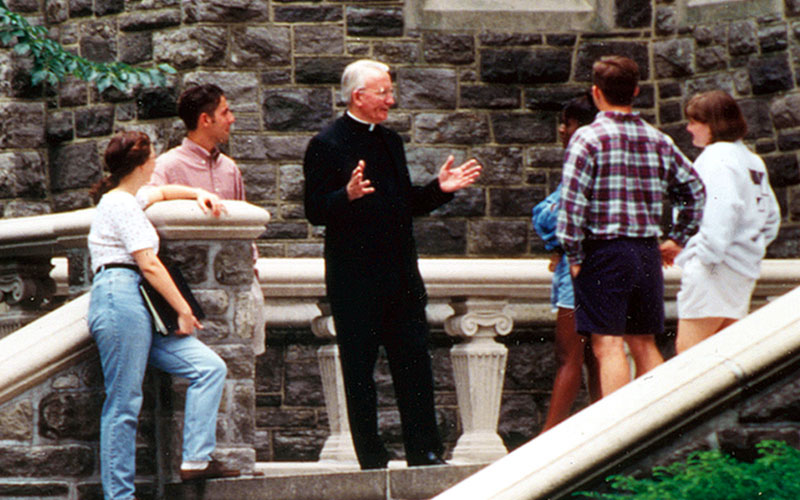
The school’s endowment rose from $36.5 million to $271.6 million, enabling the addition of approximately 1.1 million square feet of academic and residential space, and the renovation of more than 1 million square feet of existing space on the Lincoln Center and Rose Hill campuses. Four new residence halls were built at Rose Hill, including Millennium Hall, opened in 2000 and later renamed O’Hare Hall. The Lincoln Center campus saw the addition of its first residence—the 20-story McMahon Hall—in 1993.
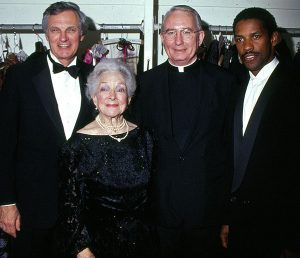
In 1991, the University’s sesquicentennial year, Father O’Hare announced the launch of a $150 million fundraising campaign—the largest of its kind at the time for a Jesuit university. Nearly one-quarter of all alumni contributed, and more than two-thirds of funds raised came from individuals, many of whom had no previous connection to the University. The campaign helped to create 170 endowed scholarships as well as several new faculty chairs. Fordham surpassed its goal by $5.6 million.
One of the campaign’s many successes—and one of Father O’Hare’s outstanding legacies—was the construction of the Walsh Family Library, a world-class facility that opened in 1997 at Rose Hill and was subsequently ranked No. 6 in the country in the Princeton Review.
Robert Campbell, GABELLI ’55, former vice chairman of Johnson & Johnson who served as Fordham’s board chair during much of the 1990s, said that as a leader, Father O’Hare showed a “willingness to take risks.” He recalled Father O’Hare telling him that Fordham had been talking about building a new library for 50 years.
“He went to the board with it and they went along,” he said. “It was very symbolic, because it was tied to a major campaign and because it said Fordham’s on the move. New York was a tough place, and we were there to compete with anyone.”
Campbell said Father O’Hare’s determination was complemented by “his sincerity and his sense of humor that always came through.”
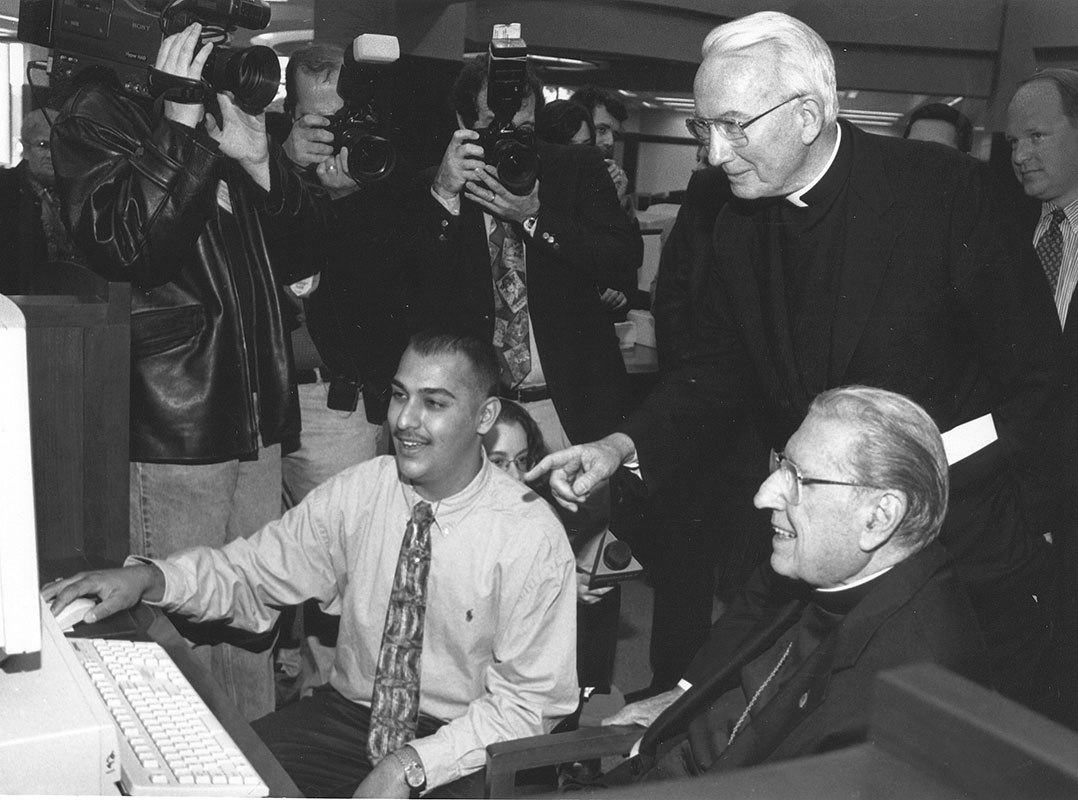
As a native New Yorker and a Jesuit committed to social justice, Father O’Hare saw great potential in a stronger unification of Fordham’s two New York City campuses, which he helped achieve through the restructuring of faculty and adoption of a shared core curriculum. He felt that each location had much to teach students.
“Fordham men and women have found in the city rich cultural resources, but also daunting moral and social challenges, soaring celebrations of the human spirit here at Lincoln Center, but also a summons to service in the neighborhoods of the Bronx. These different faces of the city engage the classical Renaissance humanism of Jesuit education, but also the new Jesuit humanism that adds to this classic ideal the urgency of education for justice,” he said at Fordham’s 160th Anniversary Dinner at the New York State Theater in 2002.
Influence and Reach
Father O’Hare’s influence extended far beyond Fordham and New York City in many ways, not least of which are the accomplishments of those who worked for him.
“In his 19 years as president, he helped mentor many Fordham colleagues into their own presidencies, including me,” said Fordham Trustee Donna Carroll, Ph.D., University secretary under Father O’Hare and current president of Dominican University in Chicago. “He said something to me once that guides me still: ‘You choose to see the limits or the possibility in Catholic higher education. What you choose determines how you lead.’”
Demonstrating a commitment to Fordham’s many Catholic traditions, Father O’Hare helped establish Fordham’s Center for American Catholic Studies, the Institute of International Humanitarian Affairs, and the Laurence J. McGinley Chair in Religion and Society, for which he recruited Avery Dulles, S.J. (before he was elevated to cardinal). He made many international trips in service to Fordham and the Jesuits, traveling to 26 countries during his presidency.
Principled Civic Leadership
Father O’Hare devoted equal time to forging Fordham’s relationships with New York City. In 1988, Mayor Edward I. Koch made him the founding chair of the New York City Campaign Finance Board, one of the nation’s groundbreaking models for campaign finance reform. So ethical was Father O’Hare’s leadership, said Mayor Koch, that the board even fined his mayoral staff for errors made in campaign contribution reporting. Father O’Hare held the position for 15 years. In late 1993, Mayor David N. Dinkins refused to reappoint Father O’Hare after the board fined the Dinkins campaign $320,000. But Mayor Rudolph Giuliani reappointed him when he took office in 1994.
“It could’ve been a nothing job if it didn’t have a superb leader willing to take on every person in politics,” said Mayor Koch. “He made the job.”
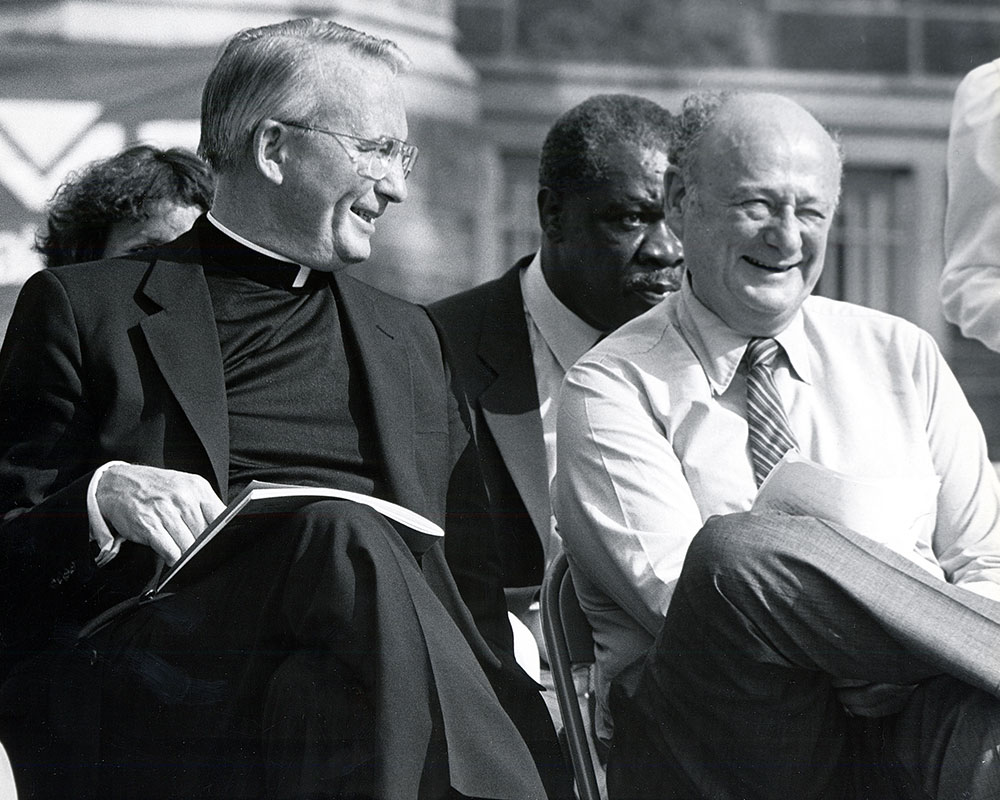
U.S. Supreme Court Justice Sonia Sotomayor worked with Father O’Hare as one of the Campaign Finance Board’s founding appointees.
“Father O’Hare is one of my heroes,” said Sotomayor, a Bronx native who has remained close to Fordham, receiving an honorary degree at 2014’s commencement and attending many University events. “Brilliant, witty, kind, gentle but firm, he lived his life caring and giving to so many. The nation, the city of New York, and the Bronx have lost a great man. I have lost a friend I greatly admired but whose principles continue to guide my life.”
Former Mayor Michael Bloomberg praised Father O’Hare for his integrity.
“Father O’Hare not only began a renaissance at Fordham, he helped clean up corruption in city politics as the founding chair of the Campaign Finance Board,” Bloomberg said. “Appointing him to that post was one of Mayor Koch’s best decisions. He was scrupulously honest, fiercely independent, and never afraid to speak his mind, even when it rubbed elected officials the wrong way. Thanks to him, the city’s public matching funds program, which I was glad to expand, became a national model. In a city of legendary Irish pols, one of the very best never ran for office—but he left a mark on politics like no other.”
Mayor Koch joined several celebrities, religious leaders, and alumni to pay tribute to Father O’Hare when he received the 2003 Fordham Founder’s Award. Present were Cardinal Edward Egan; Cardinal Dulles; best-selling author and Fordham alumna Mary Higgins Clark; CBS newsman and Fordham alumnus Charles Osgood; and Fordham’s incoming 32nd president, Father McShane.
Accepting the award, Father O’Hare—a proud Irishman and humorist—characterized the ceremony.
“It’s something like an Irish wake,” he joked. “Everybody should have one before they die.”
Fordham’s Pastor
Father O’Hare was more than the University president; he was Fordham’s chief pastor and storyteller. During his tenure, he celebrated more than 7,000 Masses, including a Mass of Remembrance and Hope following the attacks on September 11, 2001, which killed three Fordham students and 36 alumni. He performed countless nuptials, burials, and baptisms for members of the Fordham community. He awarded more than 60,000 diplomas and cheered at more than 900 athletics events.
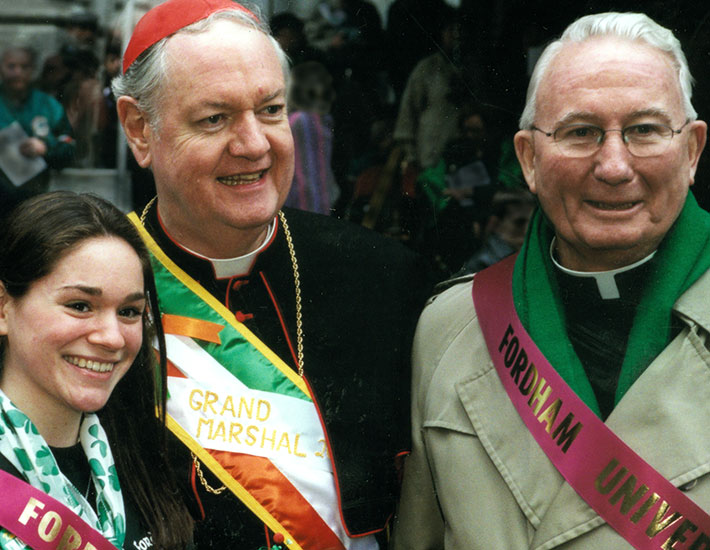
John Feerick, dean emeritus of Fordham Law, recalled Father O’Hare’s pastoral and professional support.
“Father O’Hare meant everything to me when I served as dean of the Law School. He supported me in difficult moments and was always a wise counselor on academic issues and public service undertakings. We owe much to him for the success the school enjoys today,” Feerick said.
“More personally, I will always remember that he was on the altar when my parents died and 10 years later when my brother Donald died. And how can I forget the many times we walked alongside each other in St. Patrick’s Day parades? I watched people wave and call out to him as he waved back with a smile, all while maintaining his quick stride. In everything he was insightful and brought to every occasion a wonderful sense of humor. I will greatly miss him as I had no other friend like him.”
After he stepped down as president in 2003, Father O’Hare served for one year as president of Regis High School, his alma mater. He then returned to the staff of America as associate editor, retiring in 2009. In 2015, with Fordham as a co-sponsor, the magazine established the Joseph A. O’Hare, S.J., Postgraduate Media Fellowship in his honor.
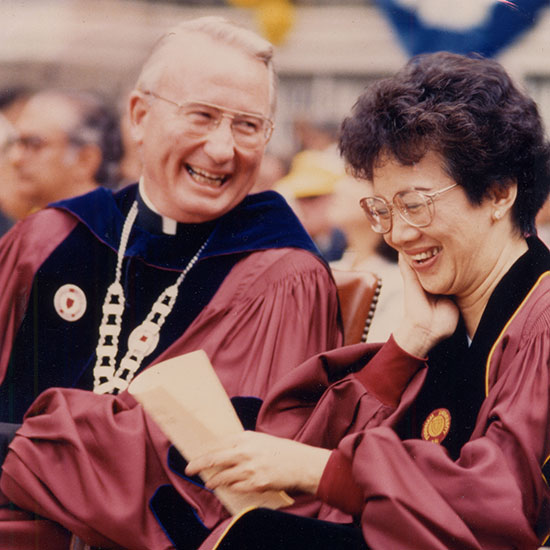
Father O’Hare was the recipient of 11 honorary degrees, including one from Fordham. He served as chairman of both the Association of Catholic Colleges and Universities and the Association of Jesuit Colleges and Universities, a trustee of the Asia Society, and a member of the Charter Revision Commission of the City of New York, among other appointments. For his contributions to the city, he received the 1992 Civil Leadership Award from the Citizens Union of New York. Legendary New York Post columnist Jack Newfield called Father O’Hare “the conscience of campaign finance reform and walking gravitas,” ranking him 44th on a list of “New York’s 50 Most Powerful People” in 1997.
A few years before he left his post as president, Father O’Hare spoke to radio listeners about St. Ignatius Loyola, founder of the Jesuits: “I have always preferred the image of Ignatius the Pilgrim to Ignatius the Soldier,” he said on WFUV’s Fordham Focus on July 30, 2000. “Ignatius the Pilgrim undertook a journey to seek the will of God, searching to discern what the greater glory of God demanded of him and his companions. Such a search, of course, will always challenge the status quo. What has been and what is can never exhaust the vision of what could be and what should be.”
Father O’Hare was preceded in death by his parents; his brother, Gerard O’Hare; and his sister, Marie Scesney. He is survived by nine nieces and nephews and several great-nieces and nephews. A private burial will be held in Jesuit Cemetery, Auriesville, New York. Once the present health crisis has passed, a memorial Mass for Father O’Hare will be celebrated in the University Church. Contributions in his honor may be made to the Joseph A. O’Hare Endowed Scholarship Fund at Fordham. Notes of condolence may be mailed to his niece Claire Scesney Lundahl at 247 East 77 Street, Apt. 5C, New York, NY 10075.
Additional Tributes to Father O’Hare
The Rev. Edward A. “Monk” Molloy, C.S.C., President Emeritus, Notre Dame
Joe O’Hare was a multifaceted leader—as priest, editor, writer, and teacher. Blessed with a great sense of humor, he was a person of vision with a strong international perspective and a deep commitment to Gospel values and human rights. He and I had some wonderful adventures together. He will be deeply missed.
The Rev. John Cecero, S.J., Provincial of the Jesuits’ USA Northeast Province
Father O’Hare was president of Fordham when I began my tenure as an assistant professor of psychology at the University. I had only known him previously through his work as editor in chief of America magazine, and despite his lofty pedigree as a widely respected intellectual, institutional chief executive, and civic leader in New York City campaign reform, he humbly and graciously welcomed me as a new Fordham Jesuit to meet with him to discuss my preliminary research interests and even to solicit some funding to support them! Joe led with insight, wit, and uncompromising loyalty to the Society of Jesus and our mission in higher education, and I will always be grateful for the inspiration that he imparted to me and to so many other Jesuits and lay colleagues at Fordham University.
Paul Guenther, FCRH ’62, Former President of Paine Webber, Former Chairman of the New York Philharmonic, and Former Chair of Fordham’s Board of Trustees
Whenever Joe O’Hare was present, there was an aura which everyone felt. He was an iconic New Yorker, a pastor, and a friend.
Tom Kane, GABELLI ’61, Retired Investment Banker, Former Fordham Board Chair
My long friendship with Father Joe O’Hare began when I joined the Fordham board as a trustee in 1986. We kept a friendly banter going between our two alma maters, Regis and Xavier high schools, throughout our time together.
In 1986, after joining the board, my wife, Judy, and I traveled to Manila for a reception hosted by a fellow trustee, Jose Fernandez, who at the time was minister of finance for the Philippines. The high point of the visit was an audience with the new president, Cory Aquino. Father Joe had been ordained at the Ateneo de Manila and so was friendly with her. (Yes, after the meeting, we did get a Cook’s tour of the shoe collection of Imelda Marcos.)
During the visit, Father O’Hare issued an invitation for President Aquino to visit Fordham while in New York for the opening of the U.N. in September. She graciously accepted.
With the ascension of Mrs. Aquino to the presidency, Philippine nationalism in the world became renowned. On September 22, 1986, Fordham held a special convocation in honor of President Aquino’s visit to Rose Hill. She was presented with an honorary doctorate.
Edwards Parade was packed with Filipinos and Filipino Americans numbering in the thousands and bedecked with yellow ribbons and scarves. The press estimated the crowd at 5,000. When they spotted President Aquino, they went wild with celebration and chanted her name—Cory, Cory! The air was electric.
Gathering himself for a few moments, Father O’Hare then began his remarks in fluent Tagalog, and spoke for over five minutes before switching over to English. To say the crowd went wild with emotion at Joe’s linguistic gesture would be a massive understatement.
Jeffrey Gray, Fordham’s Senior Vice President for Student Affairs
Tall with broad shoulders and a gray mane, regal and striking in appearance, Father O’Hare was a towering figure on campus, in the world of New York City politics, and in the Society of Jesus globally. Anyone who met Joe O’Hare was left with the impression that he could carry the world on his shoulders. A man of unmatched intellect, and personal and professional substance and depth, he was a confident, independent, deep-thinking, and fearless leader who never backed down from a challenge or a challenger. He was a proud New Yorker and man of great loyalty, with a mischievous streak and well developed, wry sense of humor.
Brian Byrne, Former Vice President for Fordham’s Lincoln Center Campus
Father O’Hare grew in his role as University president over his long tenure and in turn grew those who worked closely with him. He had an astonishingly flexible intellect, mastering not only the nuances of the academic world but also the game of politics in his tenure as the first chair of the New York City Campaign Finance Board and president of the Commission of Independent Colleges and Universities.
As a Jesuit priest, however, he always kept his priorities in order. I remember a critical visit to the Albany power brokers with other university presidents which was delayed because Father O’Hare had promised to say Mass in a local parish. He was a student of the ironic in life, frequently noting his tendency to tell the world how it should behave yet remaining firm in his commitment to advance fairness and civility.
Bruno M. Santonocito, Former Fordham Vice President for Development and University Relations
Father O’Hare’s 19-year presidency set in motion some of the foundational steps that have led to the extraordinary success Fordham University enjoys today. He revitalized and reengaged the alumni community’s commitment to Fordham. He spent numerous hours with alumni either individually or at small gatherings or when giving his state of the University message to the various alumni chapters around the country and abroad. Through these activities, Father was able to recruit an active and involved Board of Trustees who were critical to the successful completion of the Fordham University Campaign in our sesquicentennial year.
He loved rubbing shoulders with our graduates who talked about him affectionately as “the priest from central casting.” And when he was with our alumni what was always on display was his charm and graciousness, his warmth, quick wit, sense of humor and mastery of the good joke and the good story. Father had style, delivery, and timing!
Finally, he had loyalty to and affection for all his vice presidents. In spite of that, he could not resist telling alumni that like a herd of elephants or a gaggle of geese, he had a “confusion” of vice presidents.
Simply put, Father O’Hare was the right man at the right time for Fordham and I feel privileged to have shared a good part of his tenure at his side.
Dorothy Marinucci, Associate Vice President for Presidential Operations
There was a brilliant Jesuit, Father John Donohue, S.J., who worked for many years as an associate editor at America magazine. He was a good friend of Father O’Hare. Whenever you visited Father Donohue as you were leaving he would say, “safe home.” I know Father O’Hare particularly liked this phrase. I know no more fitting tribute than to quote Father Donohue and say, “Safe home, JO’H.”
Nicole A. Gordon, Faculty Director of the CUNY Baruch College Executive M.P.A. program and Distinguished Lecturer of Public Affairs; Founding Executive Director of New York City’s Campaign Finance Board
Father O’Hare was the inspired choice of Mayor Ed Koch to be the founding chair of the pioneer New York City Campaign Finance Board in 1988.
The public record truly speaks for itself, including the many times when our board chair had to face off against powerful interests. Each time, Father O’Hare challenged efforts to intimidate and undermine the board, and in each instance, he prevailed. These occasions included attempts by elected officials to replace him as chair, to move the board’s offices to uninhabitable quarters, to stop valid matching funds checks to candidates, and to stack the board with a new member in the midst of public hearings on apparent (and, later, confirmed) substantial violations of the campaign finance law.
One wonderful exchange–among many on TV–was aired when a candidate’s spokesperson described how he had hired the most prominent law firm in the City to fight the CFB. Father O’Hare responded, “So, sue me!”.
Working closely with him, as I was privileged to do for some 15 years, was an experience next to none. As a leader of troops, Father O’Hare’s sharp intelligence, political acumen, crushing wit, unquestionable loyalty, and (literally) priestly status gave us daily lessons on how to operate in public and in private, especially when the job is to be independent and fair in a volatile arena and without natural allies.
Would that we had him with us now.
]]>
More than 35 graduating seniors were recognized for their extraordinary energy, time and commitment to volunteer service during their years at Fordham, as well as their post-graduate plans to carry forth the Jesuit mission of being men and women for and with others.
story continues below
 |
“We Jesuits admire you,” said John Cecero, S.J., rector of Fordham’s Jesuit residence. “You embody our core values of love in service to others.”
The students will work for Jesuit Volunteer Corps, AmeriCorps, the Peace Corps, Teach for America, and do other mission-based and non-profit work following graduation. They and their families received a send-off sponsored by University Mission and Ministry and Fordham’s Jesuit Community.
Nine of the students (pictured above) received the inaugural Father Joseph Currie, S.J., Volunteer Award for their community service, faith and justice in the spirit of Fordham’s former associate vice president for mission and ministry. They are: Cara McMenamin, Chloe Edwards, Christine Johnsen, Alice Barry, Zachary Hudson, Kendall Lewis, Tyler Kline, Christina Moehrle, and Kaylyn Toale.
Father Currie, center, who retired from his position in 2010, was on hand to meet the awardees.
In their own words, five extraordinary students describe their plans below.
Kaylyn Toale, American Studies major: “I am going to be serving with the Jesuit Volunteer Corps in Tucson, Arizona. I’ve been involved in service throughout my time here at Fordham and wanted to continue that, specifically working with women’s empowerment. I am looking forward to living in a community like JVC. I want to adopt that manner of simple living for the rest of my life, so this will start me off in that direction.
 |
Kendall Lewis, anthropology major: “I am working for City Year, a unique program in Columbia, South Carolina. I will be working in the Young Heroes program with middle school kids, doing projects around social justice. It is volunteer for a biweekly stipend, which is very small. They actually suggest we ask for public assistance to help pay our rent. This is the sacrifice you have to make to do this kind of work, living simply with basic necessities. I am doing what I am called to do with City Year. I realize how much I lacked a holistic education of myself during K through 12. And right now I want to pass that along to other students.”
 |
Christine Johnsen, political science major: “I am going to Calcutta with the Missionaries of Charity, to work in the homes of the sick and dying. I am working this summer to pay for my airfare. I also want to help teach women’s empowerment to women in the slums. My mother is going too for a few weeks, because she wanted to do service after college but couldn’t. I will be staying on for at least a few months, if not longer. I will probably come back to the States and eventually become a social worker because I want to live a life of service.”
 |
Kara Mackinson, psychology major: “I am going to Boston to work in a children’s services organization called Wediko, which does therapeutic special education. Education is so important and influential in young people. I have worked in a similar treatment program and it is very rewarding. Working with someone who has Asperger’s, or post-traumatic stress, I learned about the power of the human connection. We can all learn through the eyes and mind of someone with a disorder.”
 |
Nova Lucero, political science major: “I am going to Bolivia to work with the Good Shepherd Volunteers. Their mission is to work with women and children who have experienced domestic violence. I will be living in a safe house with the women and children, and will work on empowering them every single day. This is a program where you make of it whatever you want, bringing your individual skills to shape your work with the population. I feel in my heart that I am supposed to do international humanitarian mission work. I am from the Bronx and have lived at home for so long, in my little bubble. Even though I did volunteer work here in shelters, I want to try living and working somewhere completely different.”
]]> John Cecero, S.J., Ph.D., associate professor of psychology, has been appointed rector of Fordham University’s Jesuit residence, succeeding Vincent Duminuco, S.J., Ph.D., who had served in the position since 2001.
John Cecero, S.J., Ph.D., associate professor of psychology, has been appointed rector of Fordham University’s Jesuit residence, succeeding Vincent Duminuco, S.J., Ph.D., who had served in the position since 2001.
The rector oversees the emotional, spiritual and physical well-being of the approximately 25 Jesuit faculty members and administrators who live in Spellman Hall on the Rose Hill campus and manages the operating budget for the facility.
“I am deeply grateful to Father Duminuco for his service as rector,” said Joseph M. McShane, S.J., president of Fordham University. “He brought to the post an encyclopedic knowledge of Jesuit education, a passionate devotion to Fordham and a wonderfully pastoral concern for all of the members of the Fordham Jesuit community.”
Father Cecero, who became a member of the Society of Jesus in 1976 and was ordained in 1989, joined the Fordham faculty as an assistant professor of psychology in 1998. He is a licensed clinical psychologist and the director of Fordham’s Center for Spirituality and Mental Health.
Father McShane called him a “creative and engaging member of the psychology department and a widely recognized expert on religious life and pastoral counseling.” The Superior General of the Society of Jesus appoints all rectors, and they serve for three years and can be appointed to one additional term.
]]>